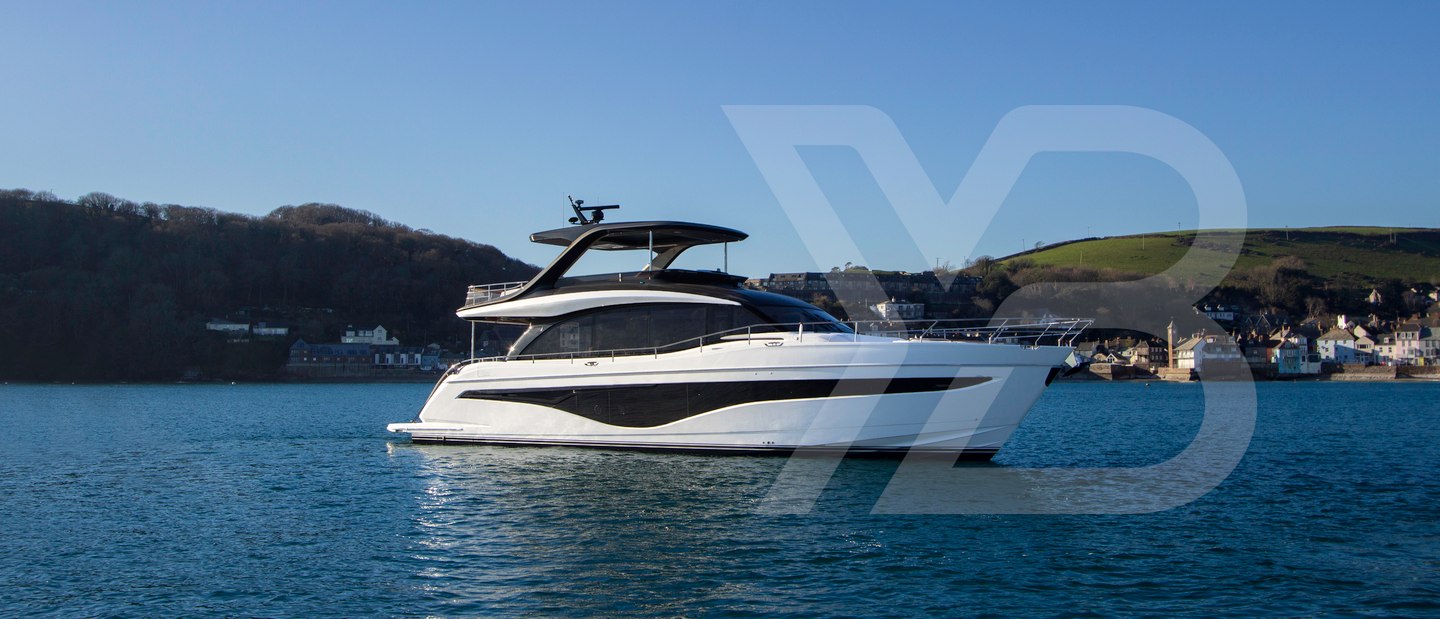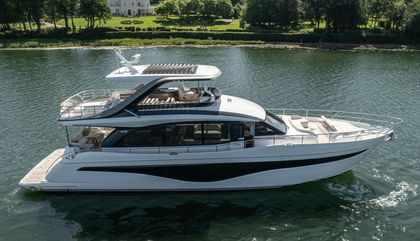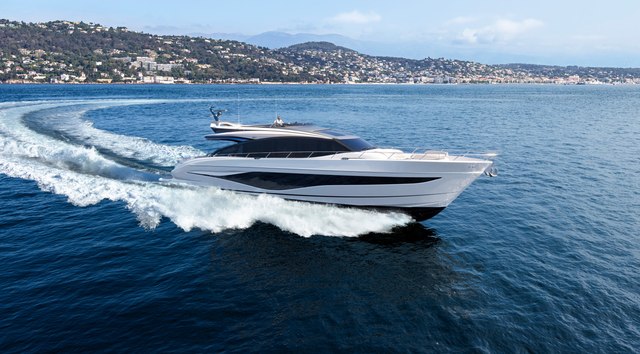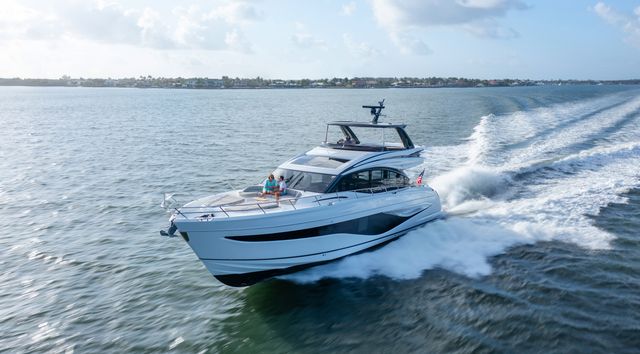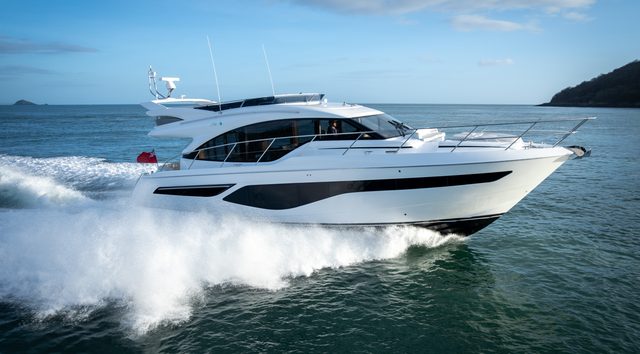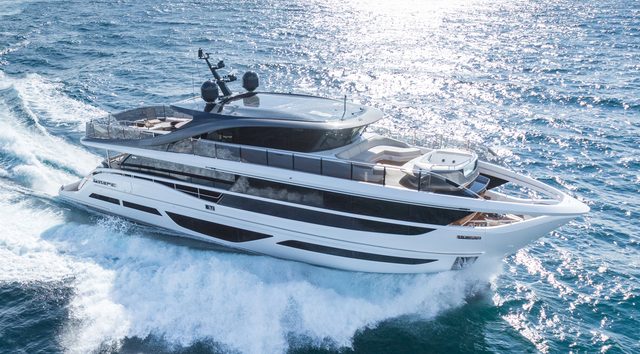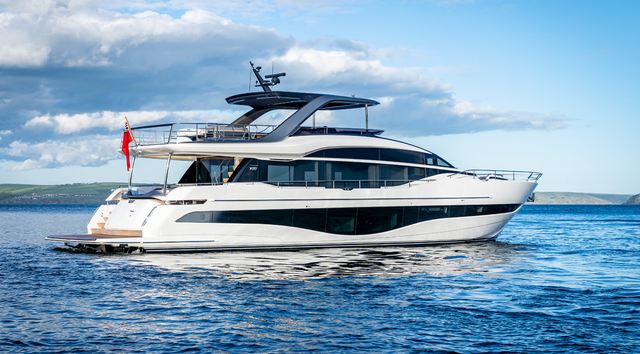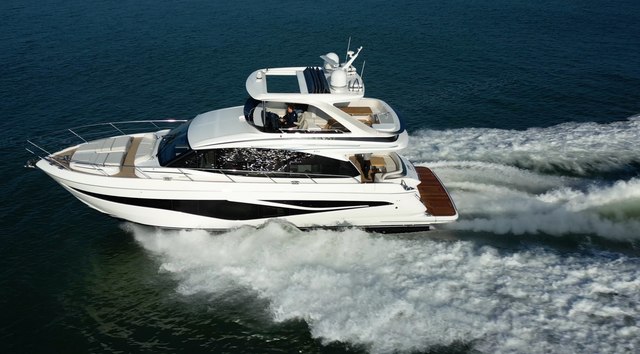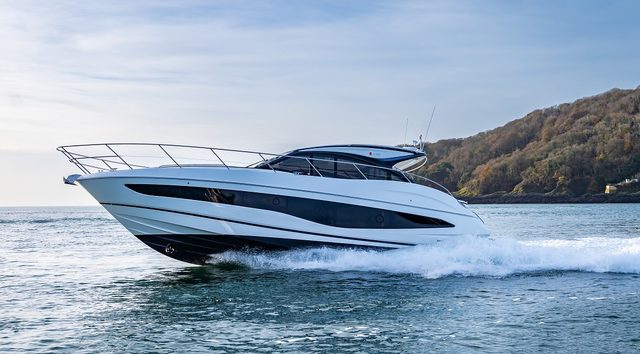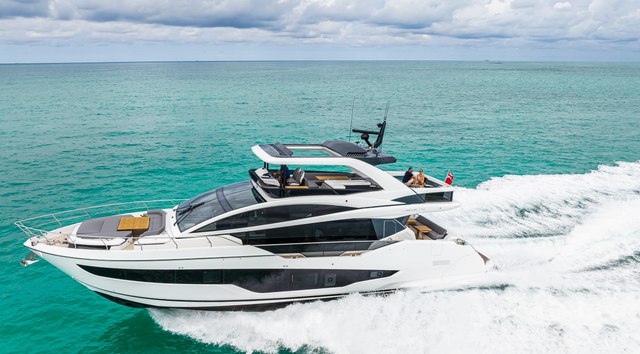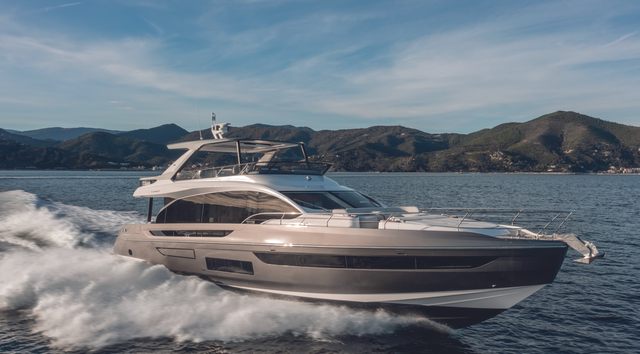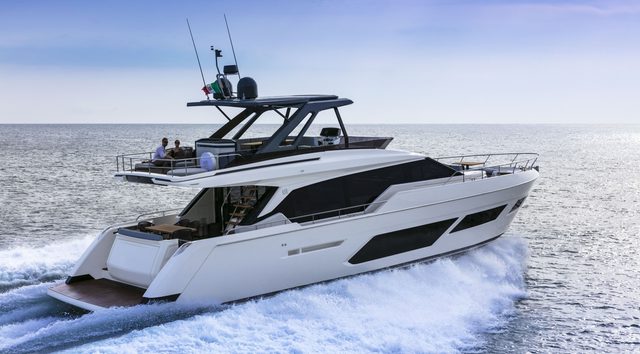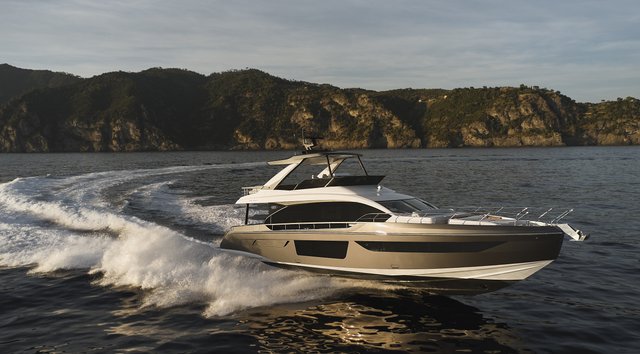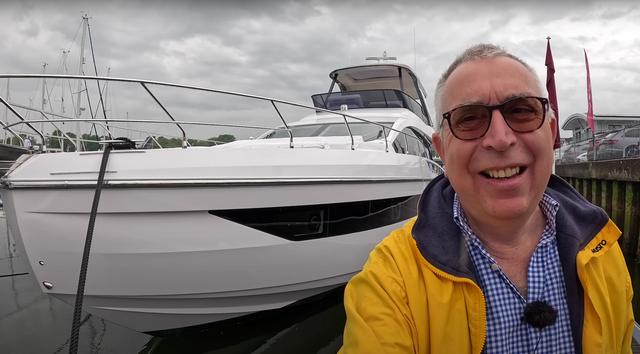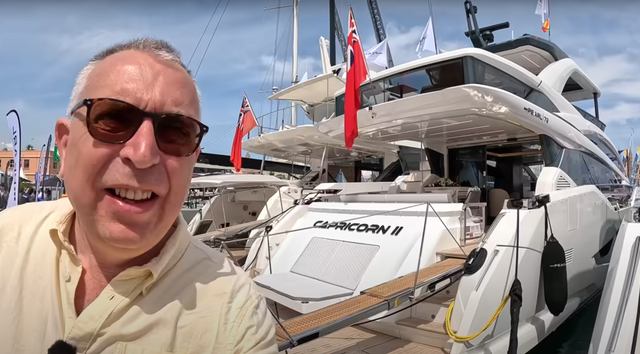"Why would you buy a flybridge boat like the Princess Y72 and keep it somewhere with unpredictable weather?" is a question that comes up often. The answer is straightforward - when the sun does appear, there’s no better place to enjoy it than from a flybridge.
If you’re in the market for a big flybridge yacht, the Y72 is a bit of a classic. Princess has already built 70 of them, with another 10 in production. In this review, the plan is to figure out exactly why it’s been so popular and how it stacks up against rivals like the Pearl 72, the Azimut 72 Fly, and the Ferretti 720 - all through an in-depth tour and a proper sea trial.
Test & Review Video
Around the Marina
The Y72 has twin MAN 1,650hp V12s on shafts with the option to add a joystick for slow-speed control. However, with the proportional bow and stern thrusters and the control you get from the throttles, a joystick isn’t something you’d feel short of. There’s loads of positivity through the controls, just nudging it in and out of gear, everything feels easy and deliberate using two big props and rudders.
Often with big engines like these, you put it into dead slow ahead, and the boat still feels like it’s charging along. Here, just ticking in gear, it eases forward at a nice, manageable pace. The extra thrust is there when you want it, but the low-speed behaviour feels considered.
The flybridge driving position helps too. Sitting down, you get a great view forward, but for manoeuvring, standing up here feels better as the all-around view is excellent. You can see right down through the hatch into the cockpit, chat easily with the crew if they’re forward, and there are cameras too if you want extra visibility. Being positioned centrally is another bonus - you’re close enough to either side to step across quickly if you need a better look.
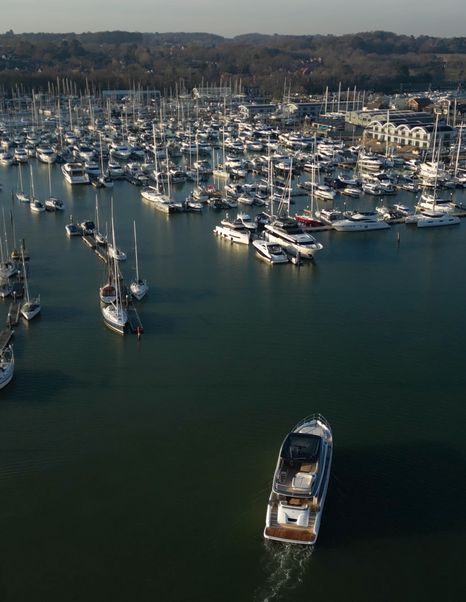
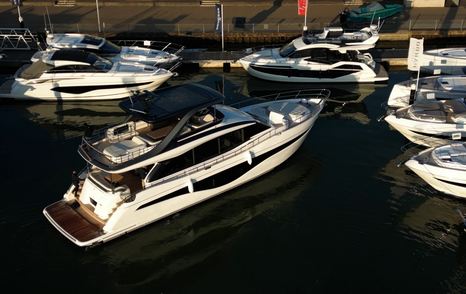
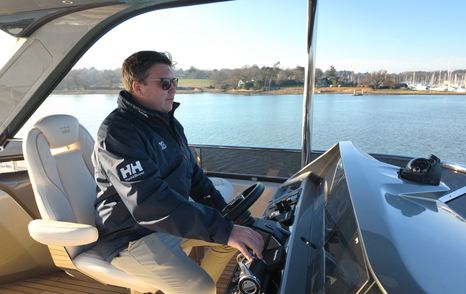
Third Station
Down in the cockpit, the third station comes into its own when backing in stern-to. Sure, you could do it from the flybridge, but being down here puts you close to where the action is. You’re right next to where the crew will be handling fenders and lines, so it’s much easier to communicate and react quickly, and with repeaters for the throttles and thrusters, you have great control.
Visibility to the bow isn’t perfect from here, but you can glance down the sides easily enough. And when it comes to coming in stern-to, the extra control and precision from this position make a big difference. The fine handling on this boat is impressive.
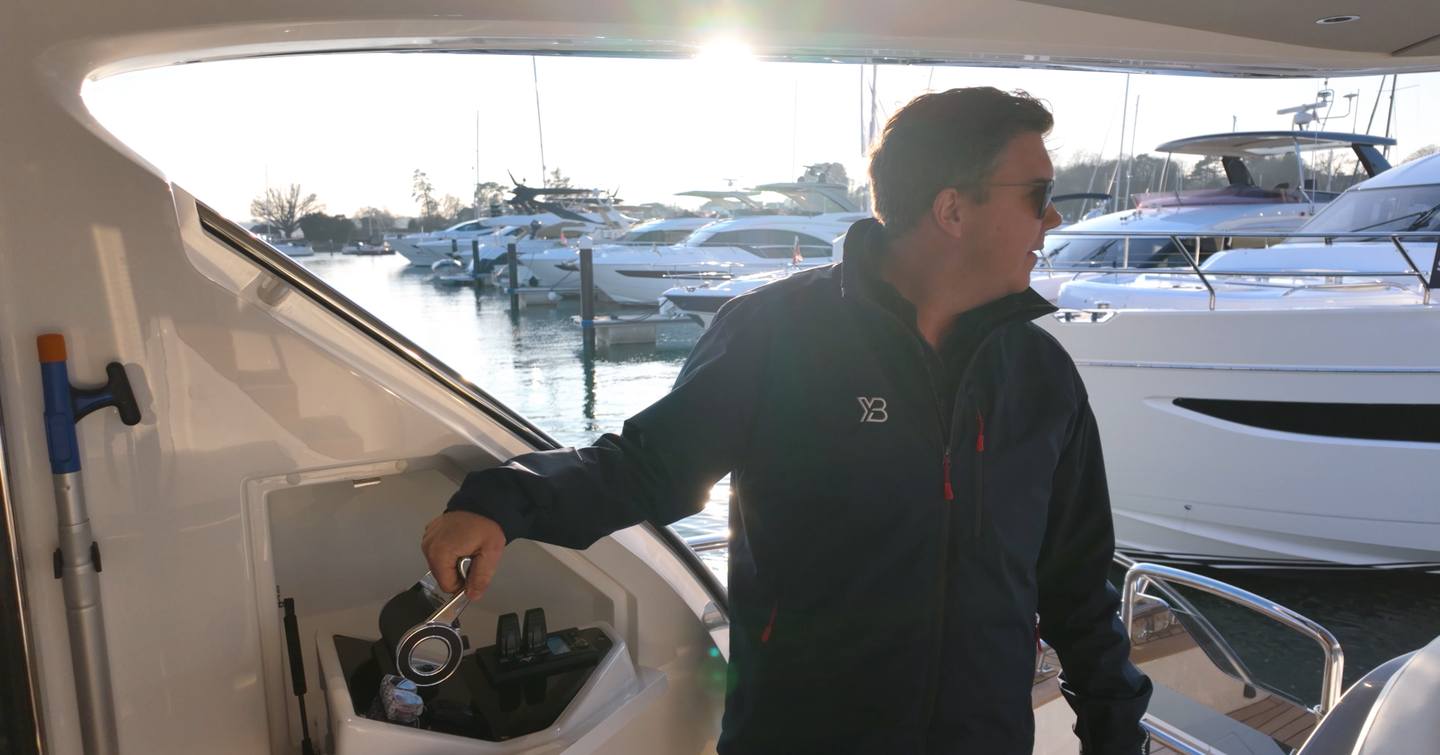
At Sea
The nice thing about a planing boat of this size is that it can be used in two ways. It’s perfectly capable of planing speeds, but if you just want to drift along at 7-8 knots, the fin stabilisers make it a very comfortable ride. With the engines ticking over at 1,100rpm, each sipping around 45 litres per hour, it’s easygoing. On a warm day, if you’re in no rush, this pace lets guests move around freely, enjoying the deck spaces and interior without any fuss.
The other side of the coin is when you have the two V12 diesel engines pushing out 1,650hp each. Open the taps, and it gets moving. That’s what you don’t get with semi-planing boats of this size. Here, it leaps up to 25 knots without any problems. With the breeze in my face and the engines humming, it’s exactly what makes this performance profile so enjoyable.
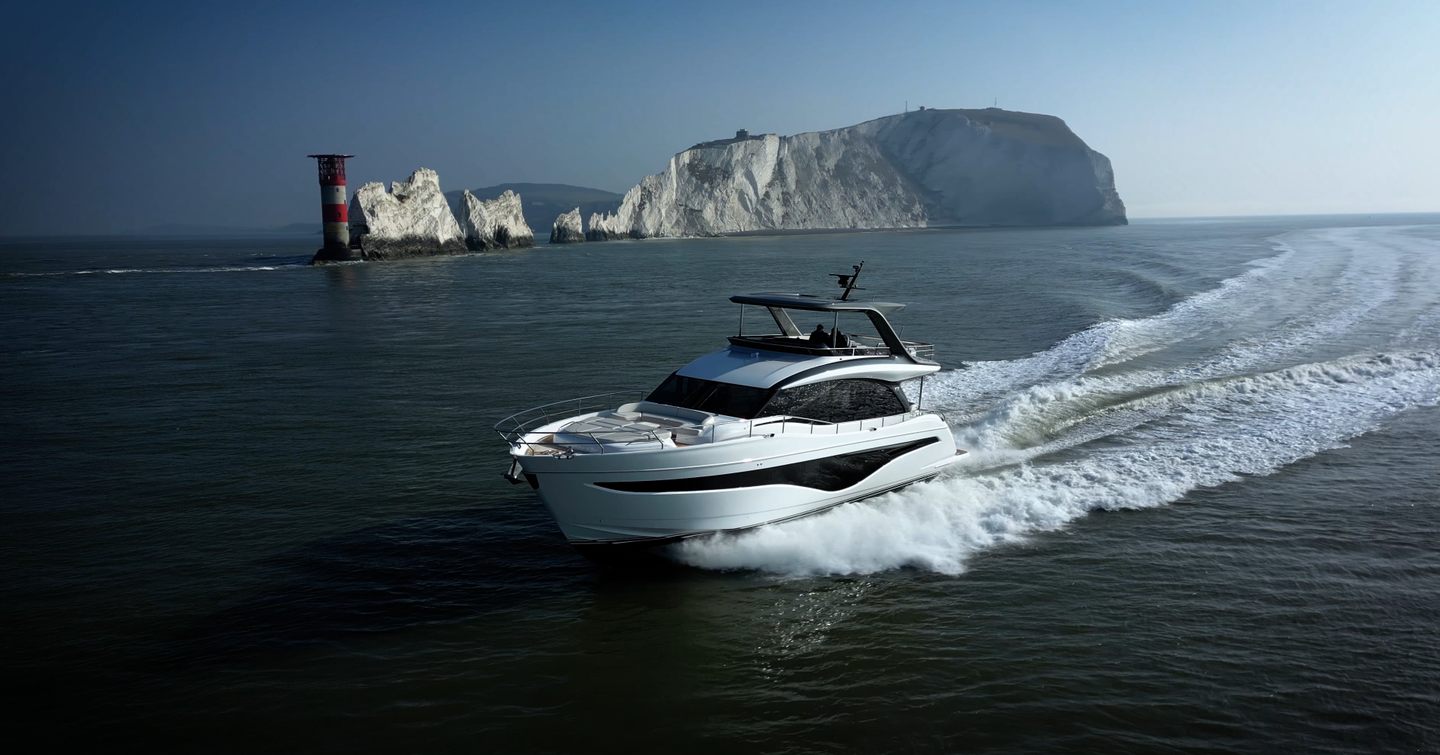
At 25 knots, just shy of 2,000rpm, the engines burn around 200 litres per hour per side, giving a range of about 275nm from the 4,500-litre fuel tank. Even flat out, you’re still looking at around 250nm. Ease it back to a steady 9 knots, and you’re up at around 600nm. That kind of flexibility suits this style of cruising perfectly. With a decent bit of tide running in the Solent, the Y72 managed 37.5 knots with the tide behind and 31 knots against it. Realistically, call it a 35-knot top speed - impressive for a yacht that’s just shy of 75ft and weighs around 50 tonnes.
If you really want to chase numbers, the S72 sports bridge version swaps in a pair of 1,800hp engines, hitting about 38 knots even in slack tide. Whether you need that much performance in a boat like this is debatable - this setup already feels very good. Even cruising at 21 knots, there’s still an extra kick when you bury the throttles - handy in big, messy seas when you need to power through troughs or climb the back of a wave.
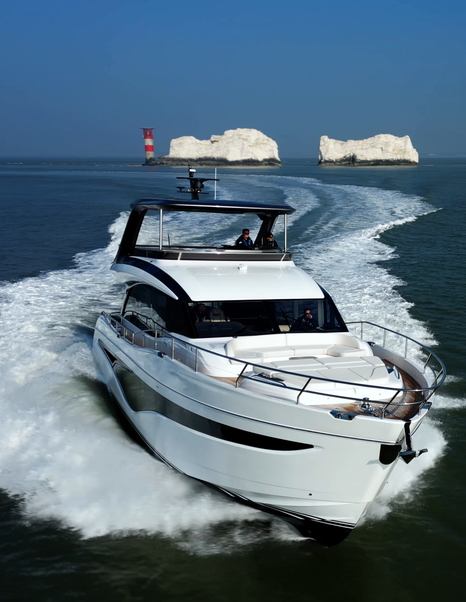
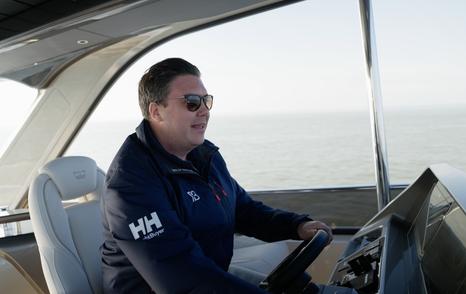
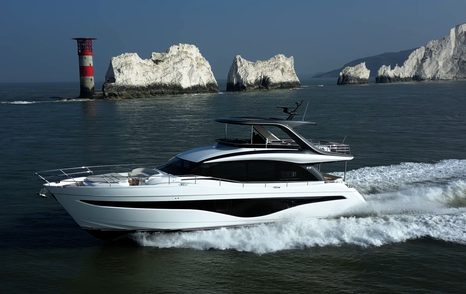
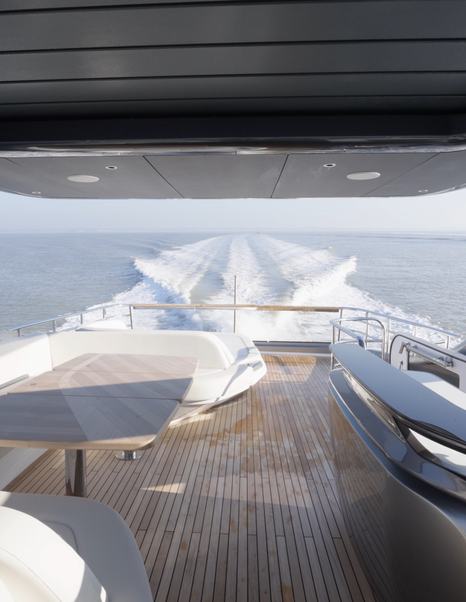
The handling, much like the performance, is a surprise. It feels slick, really sharp on the wheel, and the fin stabilisers are active here too, just trimming off the edge of any heel. That keeps the boat nice and flat, which in turn makes the handling feel quick and precise.
If you need to turn back on yourself or dodge something floating in the water, the boat reacts quickly and cleanly, just as you’d hope. Princess yachts are generally good to handle right across the range, but it feels even more impressive here, where you might not expect handling to be top of the list. They could have gotten away with something less polished, given the type of boat it is, but they haven’t.
The driving position plays a big part too. It’s close, connected, and easy to manage. No - it’s not a sports boat, and it’s not pretending to be - but everything falls to hand, and you feel in touch with what the boat’s doing.
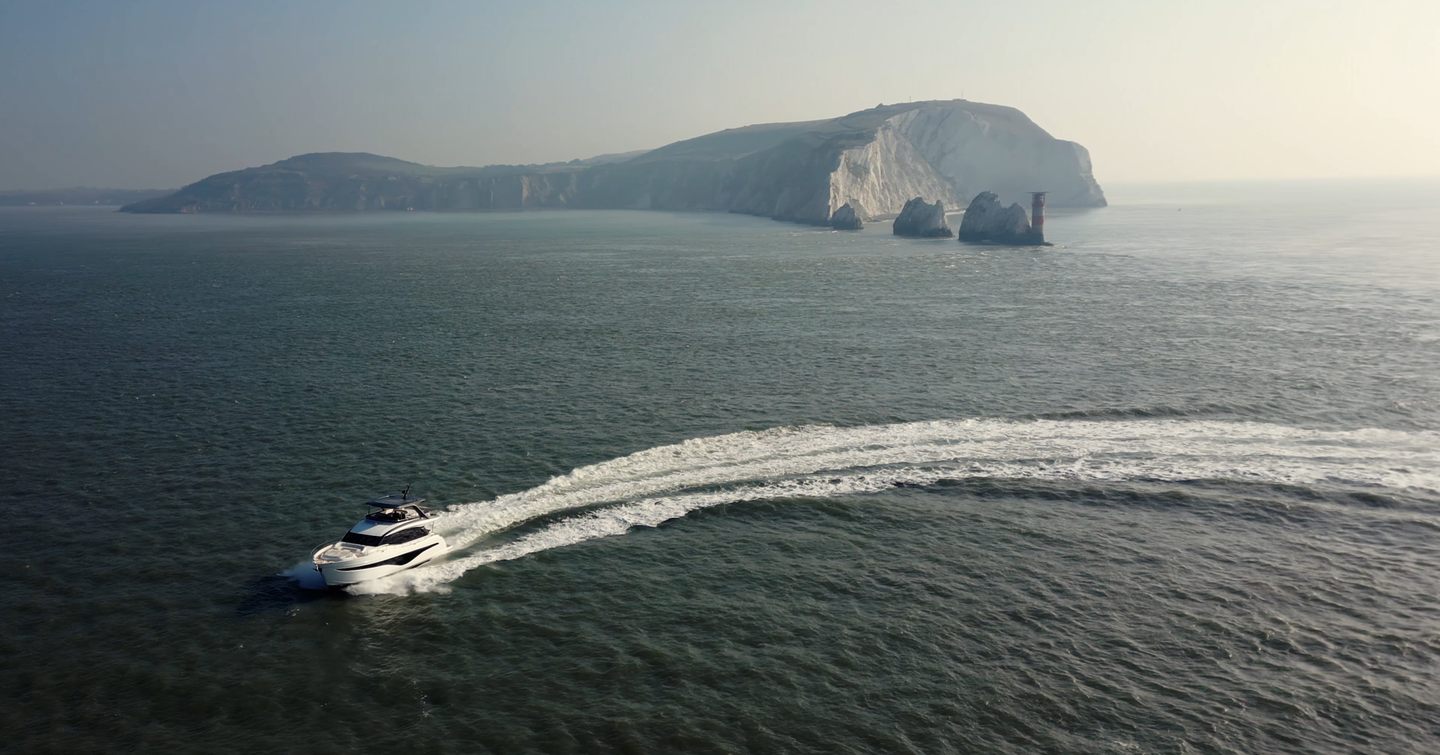
The Y72 carries the familiar design DNA of Princess, Olesinski, and Pininfarina - understated, balanced, and built to last. It’s just under 23m and weighs in at around 50 tonnes, but it handles with far more agility than you'd expect from a yacht this size. Over 70 hulls have already been delivered, with more in build, so clearly the formula works.
Every yacht in the Y Class range starts from the same foundation - strong performance, smart design, and a focus on detailing - but each one is shaped by its owner. The Princess Design Studio guides that process with a range of layout choices and interior schemes that let you tune the yacht to your style. That freedom to personalise is a big part of the Y Class appeal.
This model picks up where the Y85 left off. The layout and finish are right in line with the larger models in the range. You get a choice of timber finishes, extended teak decking as standard, quartz worktops in the galley, and formed solid surfaces in the bathrooms, with marble, granite, or quartz flooring available as upgrades. It’s high-spec throughout, but quietly so.
The hull design includes full-length glazing, similar to what you see on the Y95, giving the Y72 that unmistakable Y Class silhouette. The exterior lines are clean and sculpted, with the hull windows running the full length of the boat. Indoor and outdoor areas are arranged to balance socialising with usability, whether you're cruising with guests or spending a weekend on board as a couple.
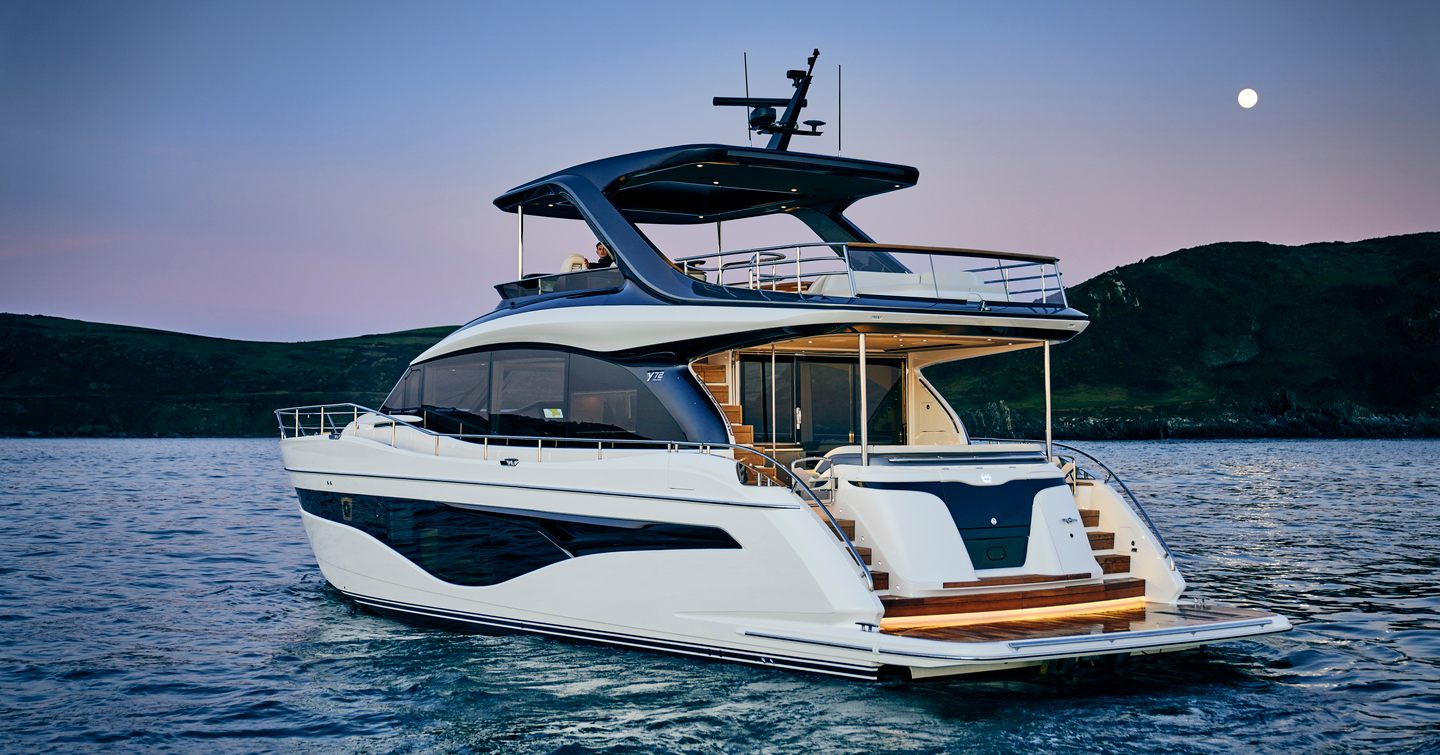
The flybridge design reflects the wider brief - sociable, flexible, and good to look at. There’s a proper wet bar with a barbecue, sink, and drawer fridge, plus a large handcrafted teak dining table opposite a U-shaped seating area. Aft is a sunpad, though you can spec that area for tender stowage with a crane if needed or swap it for three individual sunbeds. You can also add an extended hardtop with either a louvred section or a glass panel overhead.
Accommodation includes four ensuite guest cabins with a full-beam owner’s suite accessed via a private stair. It’s a setup that works well for both family use and charter, giving the owner some separation from the forward cabins. The crew space aft is basic but serviceable, with separate access and its own bathroom. It’ll suit occasional crew or extra guests on a short stay.
Inside, the saloon is open and sociable, with an aft galley, bar area, and plenty of space to stretch out. The fit-out is detailed and well thought through - soft-close stowage, hidden lighting, custom glassware drawers, and a multi-zone Naim audio system. Materials are upmarket but not flashy, and everything feels properly finished.
The Y72 gets the important stuff right. It’s a cruising yacht with the polish and layout of a larger boat and enough flexibility in both spec and performance to suit a wide range of owners.
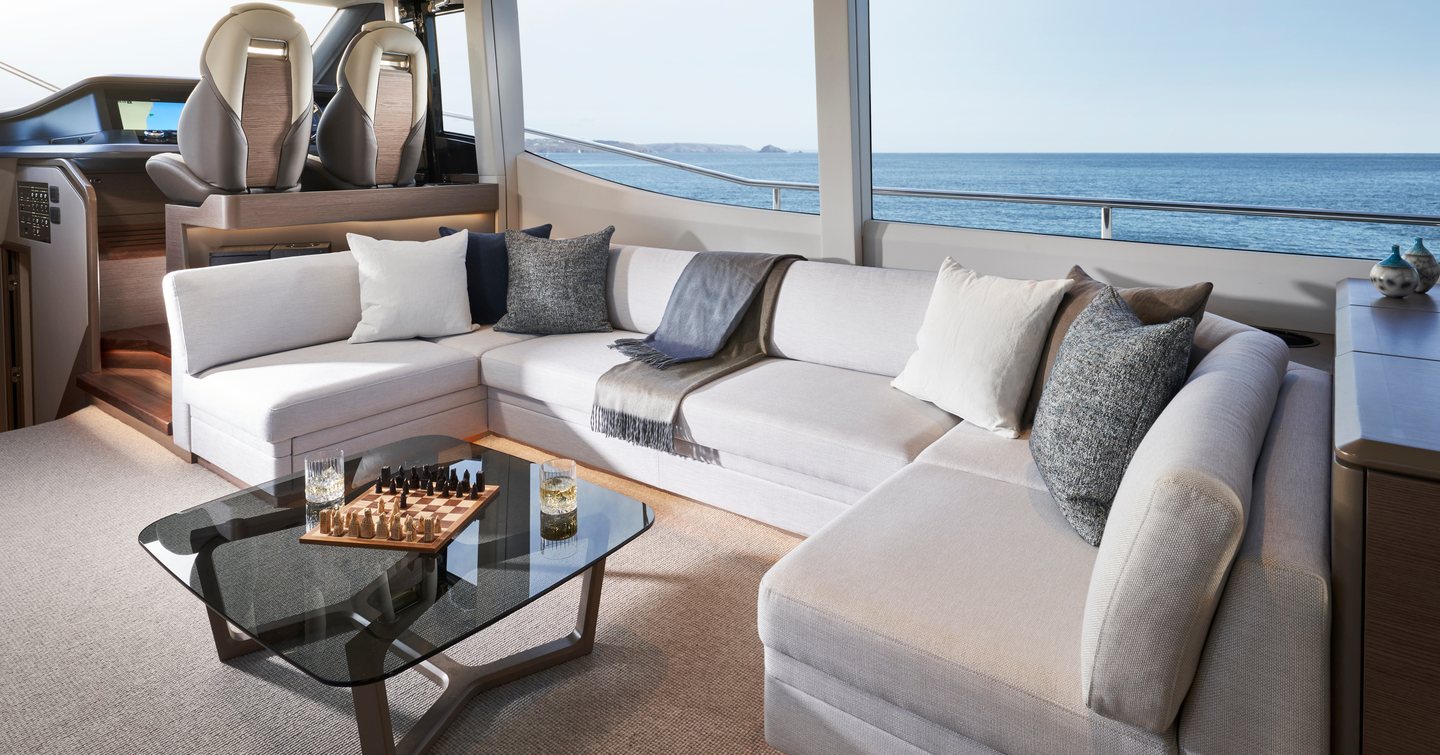
Engine Room
There are two engine options: twin MAN V12s on shaft drives, with either 1,400hp or 1,650hp. The engines use the same block and are big old lumps, but there’s good space between them, and headroom is decent, though it does get a bit tighter outboard. Key systems like the hydraulics pack and generators are separated from the engine space itself, so apart from the air-con chillers and watermaker, it’s just engines in the main space, keeping everything tidy and accessible.
There are twin generators - a 27kW main and a 19kW backup - stacked on the starboard side. The fin stabilisers alone are a £120,000 option, but if you’re planning to anchor out regularly, they will be worth it. Even with just a light swell during the test, the fins were working away, smoothing everything out effectively.
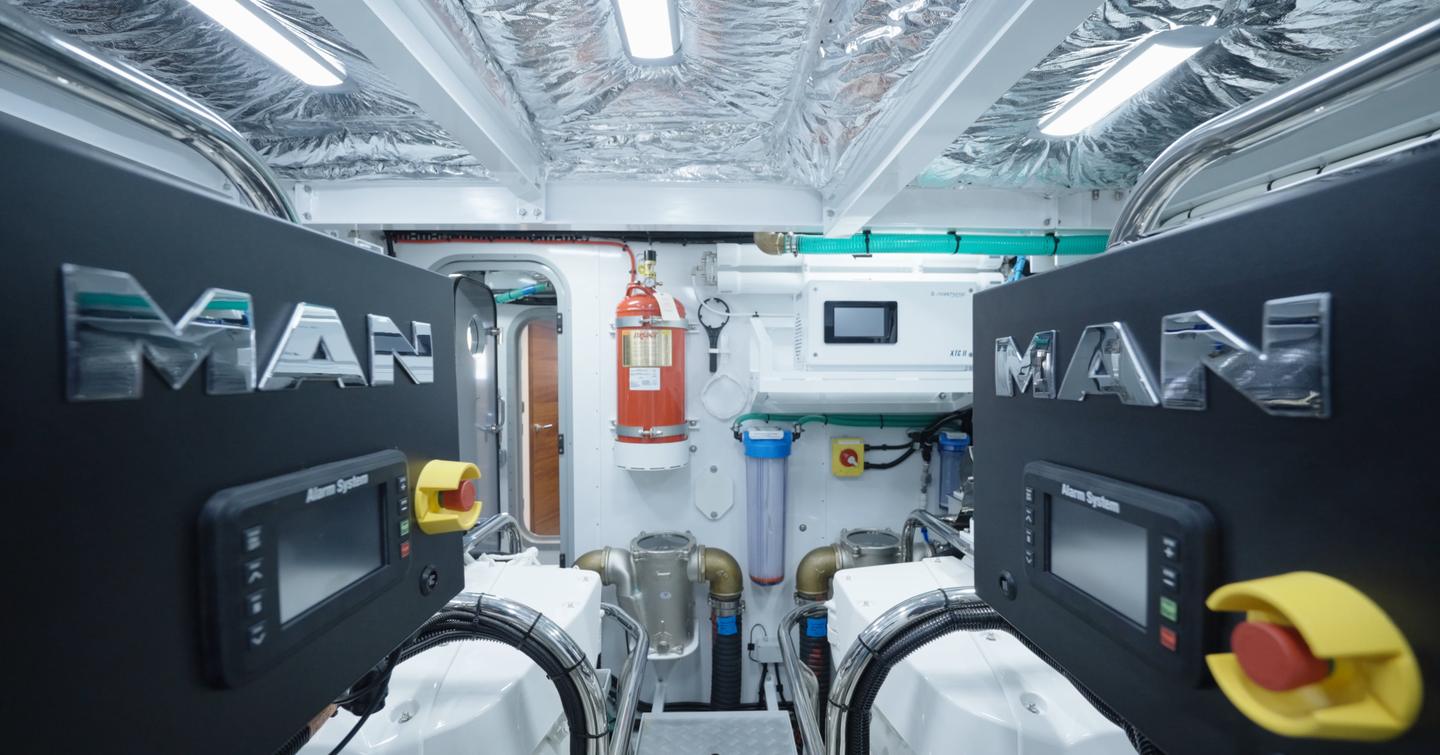
Saloon & Galley
Different builders have different ideas about where a galley should go. Absolute puts it aft, Azimut and Pearl place it amidships, and on a Ferretti, you’ll find it right forward - or on the lower deck if you want. But if you prefer an aft galley setup, this arrangement works nicely.
It sits opposite the dinette, so if you're eating inside, it’s quick and easy to serve the table. There’s a good spread of counter space, some over by the sink and a bit more here where they’ve been smart about storage too. It’s not just a slab of countertop - there’s cutlery storage, bins, and even an ice maker. Appliances include a full-size fridge and freezer on one side, induction cooking and an oven, a dishwasher, and twin sinks. Tables opposite match the one outside, opening up to a decent size when needed. The stools are free-standing, so you can move them wherever you like - perfect for a quick breakfast or just perching with a coffee.
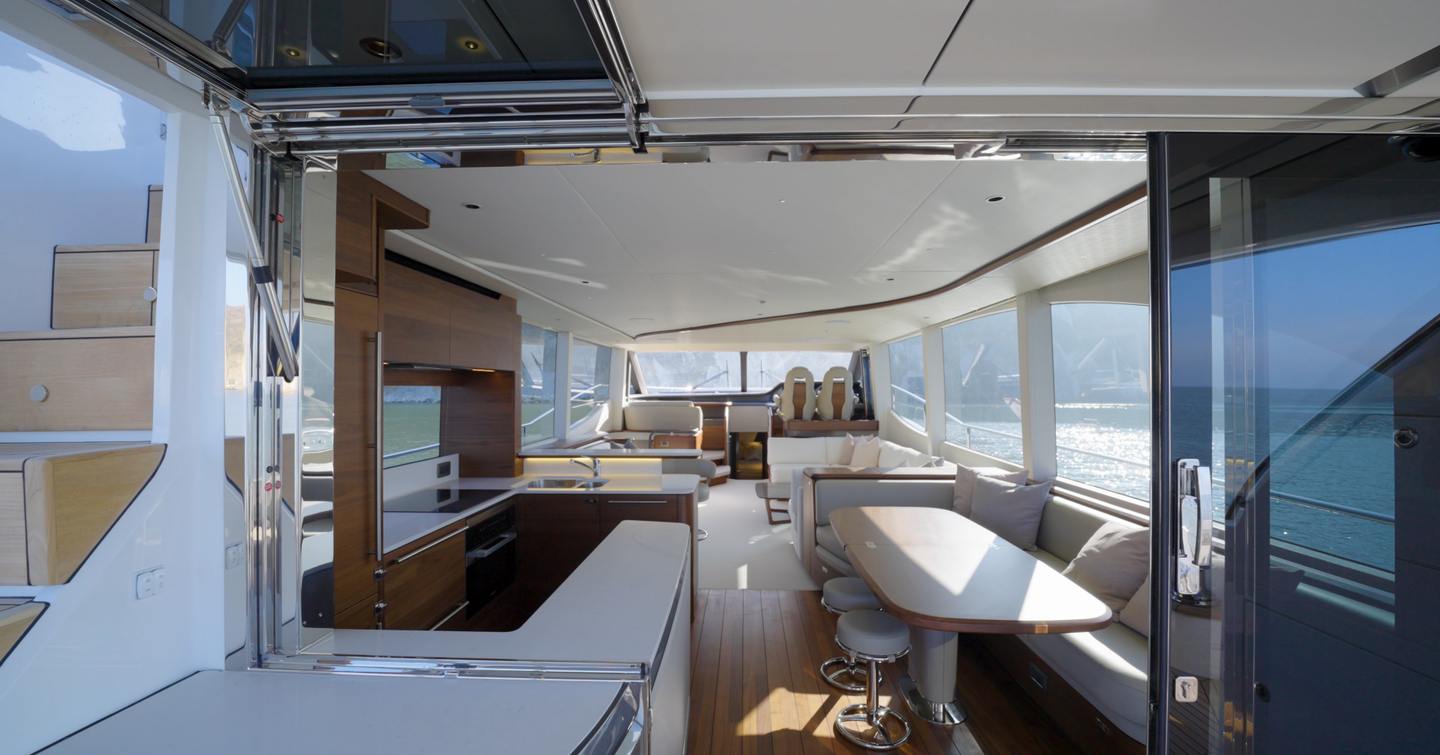
Space is used wisely. Crockery doesn’t clutter the galley - it’s stowed in dedicated fiddled lockers beneath the dinette sofa, and glassware gets the same treatment, with individual drawers for everything from tumblers to wine glasses. Very satisfying.
The stools and the additional fridge are optional, but they make more of the space. On a cold morning when sitting outside isn’t quite tempting, this would give you somewhere comfortable to sit and enjoy the view. Right next to it, there’s even more cooling space with an (optional) wine fridge.
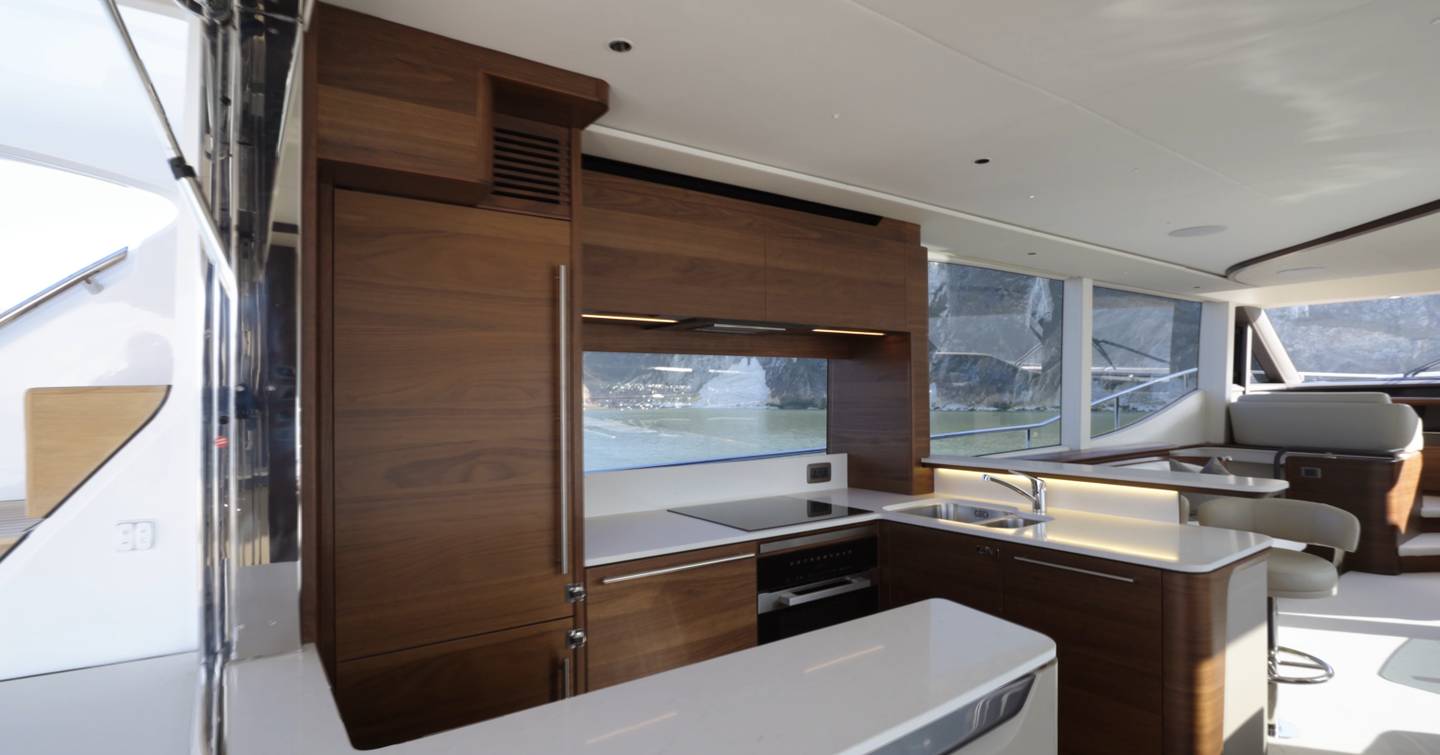

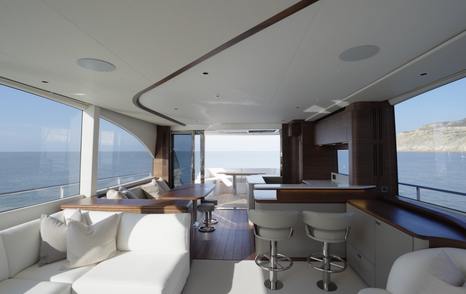
It’s not the flashiest decor - something like an Azimut or a Pearl might be prettier and more exciting - but the atmosphere here is pure class. The amount of space between the sofas stands out. You can stretch out comfortably, with a coffee table nearby, and no need for a big fixed table inside since the dinette covers that job.
The glass area around the saloon is massive, so even on a cold, bright day, you get wonderful views from inside. Underway, this is a lovely spot to sit, especially on the couple's sofa opposite the wrap of seating where the TV is hidden behind.
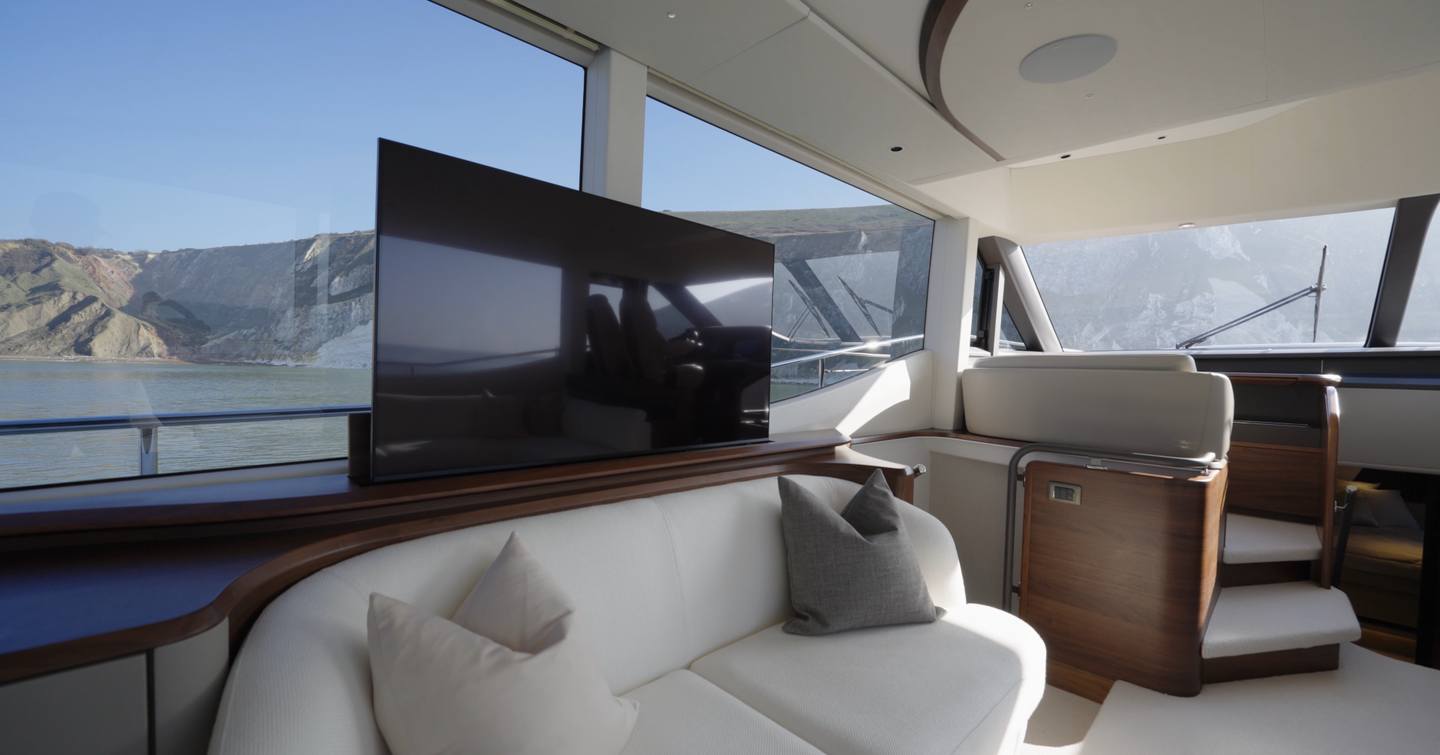
Owner's Cabin
At this size, having separate access to the owner’s stateroom works well. The staircase doesn’t feel like it’s stealing space from the interior - instead, it creates a grand entrance down into the owner’s cabin, with a bit of storage and a window along the way. There’s a smart little lobby area at the bottom too. It all flows nicely and has a knock-on effect for how you can use the boat’s accommodation.
If you’re an owner hosting a crowd, guests can settle forward. Or if it’s just the owner and family on board, everyone can live forward, and guests can take this amazing space. But honestly, if I were the owner, this is where I’d want to be. It’s full beam, amidships, with huge patches of hull window on both sides. There’s loads of natural light, and the views out from the bed are spectacular.
There’s a sofa tucked over on one side and a nicely done bureau with a run of storage above it. You wouldn’t want anything too heavy up top, but it’s a good use of space. The bureau lid lifts to reveal a vanity mirror and a spot for jewellery or smaller personal items, with even more storage underneath. There’s storage under the bed too, and the bed itself is big enough to walk around comfortably on completely flat floors.
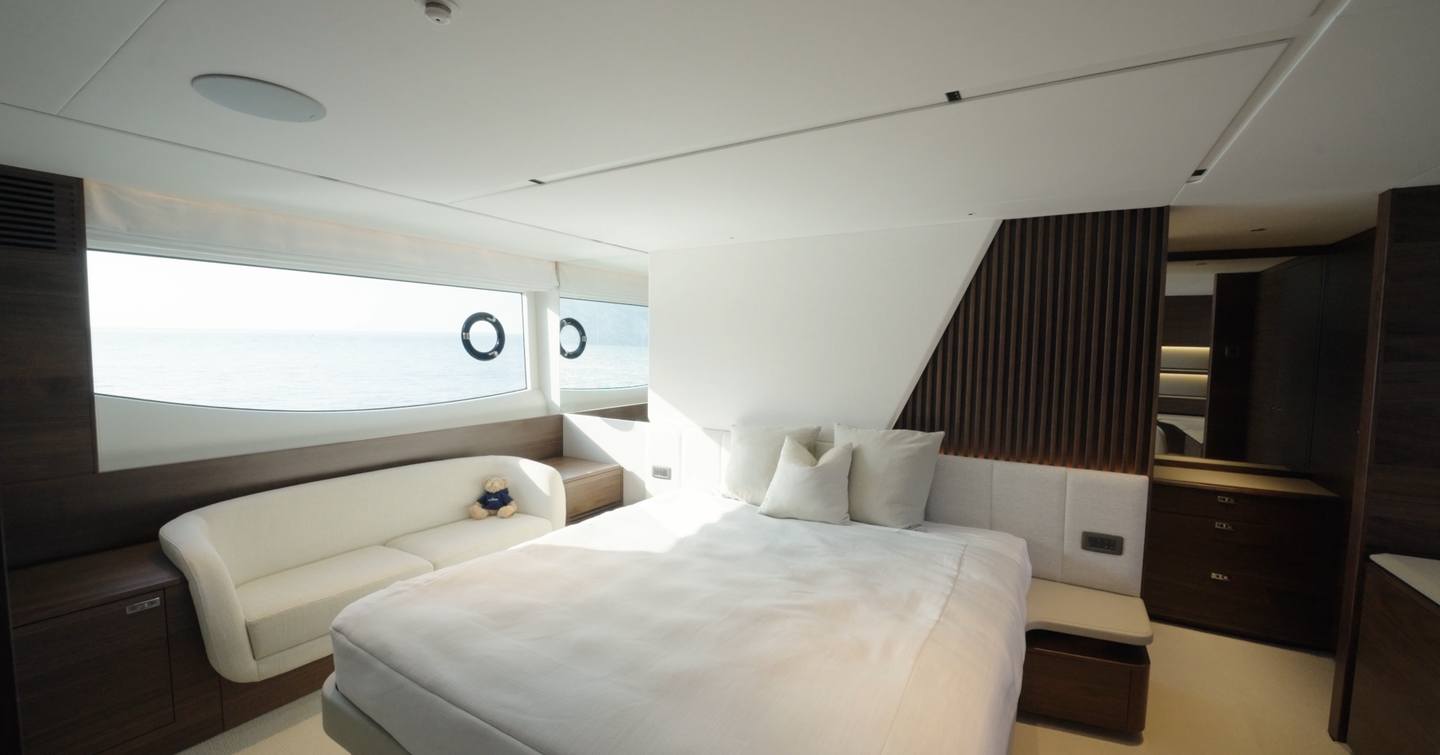
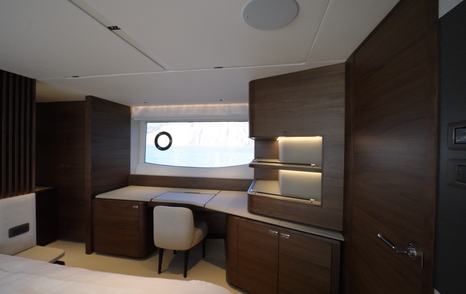

Individual bedside tables have switches for the lights and blinds, so everything can be controlled from the bed. There’s a big TV mounted on the bulkhead opposite. The decor feels subtle throughout the boat, but it comes to life down here. The way the canvas panels give way to the wood, with up-lighting picking out the veins, looks properly smart. The matte walnut finish is a £15,000 option - not cheap, but popular for good reason. It’s warm without looking dated like a gloss finish might.
There’s also some smart storage before you get to the bathroom - drawers under the bureau section, a mirror for checking you're looking sharp before heading out, and a big wardrobe. It’s half-height, but the hanging space is decent, and the auto-lighting is a nice touch.
The bathroom itself almost runs full beam and feels every bit as impressive. Twin sinks sit on a wide counter with loads of storage underneath, a heated towel rail, robe hooks, and a large shower cubicle fitted with a rain shower head, handheld wand, and a great view out through the hull window. It’s a brilliant space.
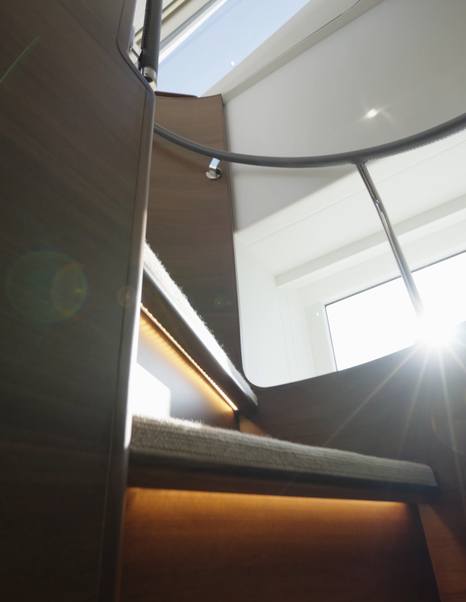
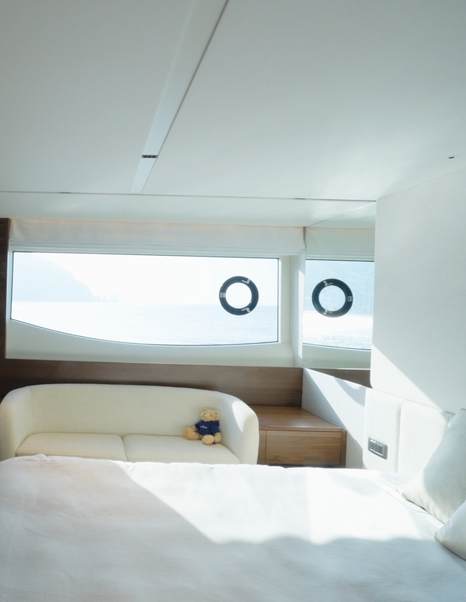
Guest Accommodation
There’s a companionway forward, adjacent to the helm, to the three guest cabins. Centrally positioned in the lobby area is the washer-dryer stack, amongst the cabins so guests can easily get to it if they want to do their own laundry.
Forward is the VIP cabin, and the floor space is very good. There’s enough room at the end of the bed for two people to move around comfortably without feeling cramped. Head height remains good, and while there’s no skylight, there is an escape hatch up onto the foredeck. Hull windows on both sides, with opening ports, keep the natural light and airflow coming in.
The VIP gets a bigger TV for a bit more of a cinematic experience, and storage is excellent too, with a large wardrobe on one side. The bathroom is completely private to this cabin - no shared access. Inside, there’s a toilet tucked behind the door, a separate shower cubicle with a hull window, and a sink set into the countertop in a typical Princess style, gently rising from the surface. It’s all very nicely finished and thoughtfully put together.
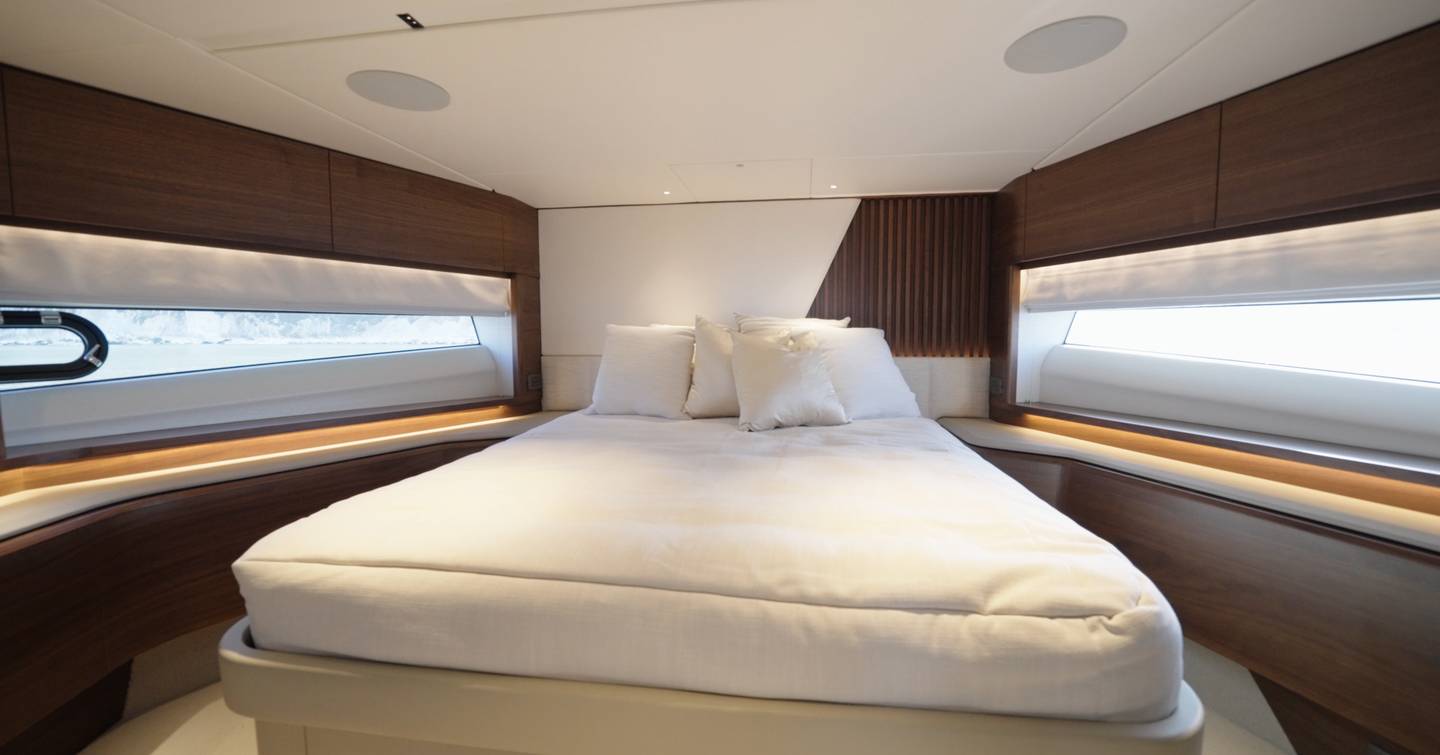
Both twin cabins come with berths that slide together to create a double - hit the button and they shift across, leaving you with a flexible layout and even keeping a bit of a bedside table on one side. Each cabin has its own TV, good-sized wardrobes, and hull windows with opening portholes for natural ventilation.
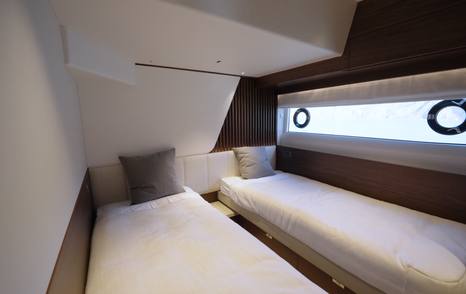
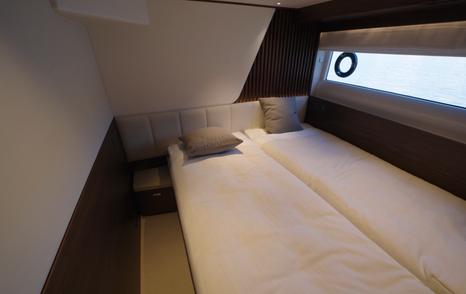
Across on the port side, the second twin is slightly larger. It still features the sliding berth setup and has less intrusion from above, giving a bit more headroom. This cabin also connects directly to the day head, offering private ensuite access - something the starboard twin doesn’t have. Space inside the bathroom is slightly narrow but well thought out, with a proper separate shower cubicle that stretches forward and has its hull window. There’s also a sink, storage, and a heated towel rail.

Crew Accommodation
Crew cabin access is on one side at the stern - a two-person crew cabin is standard on the Y72, and for a boat of this size, this is about as good as it gets for crew space. It’s not a living area - it’s a place to sleep. There’s a pair of bunks, some storage drawers, a hanging locker, and a few more lockers at eye level. No mess room, no TV, no cooking facilities - it’s an ad hoc setup for occasional crew use.
This boat sits right on the cusp of being crew-run - more likely, an owner would bring in a deckhand and run it themselves. So it’s not built for permanent, long-term crew, but for what it is - and for the size of the boat - it’s not too bad. It also has a leg up over the S72, which fits a tender garage but ends up with a much smaller crew cabin running across the beam. Here, there’s a bit more room to move around, and it’s full width too.
There’s a touch of natural light - obviously more when the door’s open - but even closed up, there’s still a window and a porthole. The cabin also gets its own separate bathroom, and the layout is pretty smart. The door into the bathroom doubles as the toilet door, a neat trick for saving space. There’s even a separate shower cubicle. Most importantly, a watertight door gives direct access into the lazarette and then through into the engine room.

Flybridge Helm
The seat slides, so if you want to lean in and properly engage with the throttles, you can - but there’s nothing directly in front of you. Even leaning right back, the bow is still clearly in view.
There are two Raymarine MFDs. The second screen is a cost option, but the Böning system comes as standard - that’s the central screen showing all the digital engine data. It’s a great setup. Engine information is right where you want it, and the way it’s arranged now, there’s radar on one side and the chart on the other. All the switches are easy to reach, too.
When leaning back though, the throttles are a bit of a stretch - but that’s nitpicking. It’s a good helm arrangement overall. Some covered storage would be useful. There are cup holders and a phone charger, but nowhere to store things like screen covers.
One other neat touch - because the armrests lift up and down, it’s easy to move between the two seats. You can’t exit between them, though, so if the navigator needs to get out, the skipper has to stand up. The helm could have been placed slightly off to one side to fix that, but sitting centrally has its perks. Situated right in the middle of the boat with a really good all-around view.
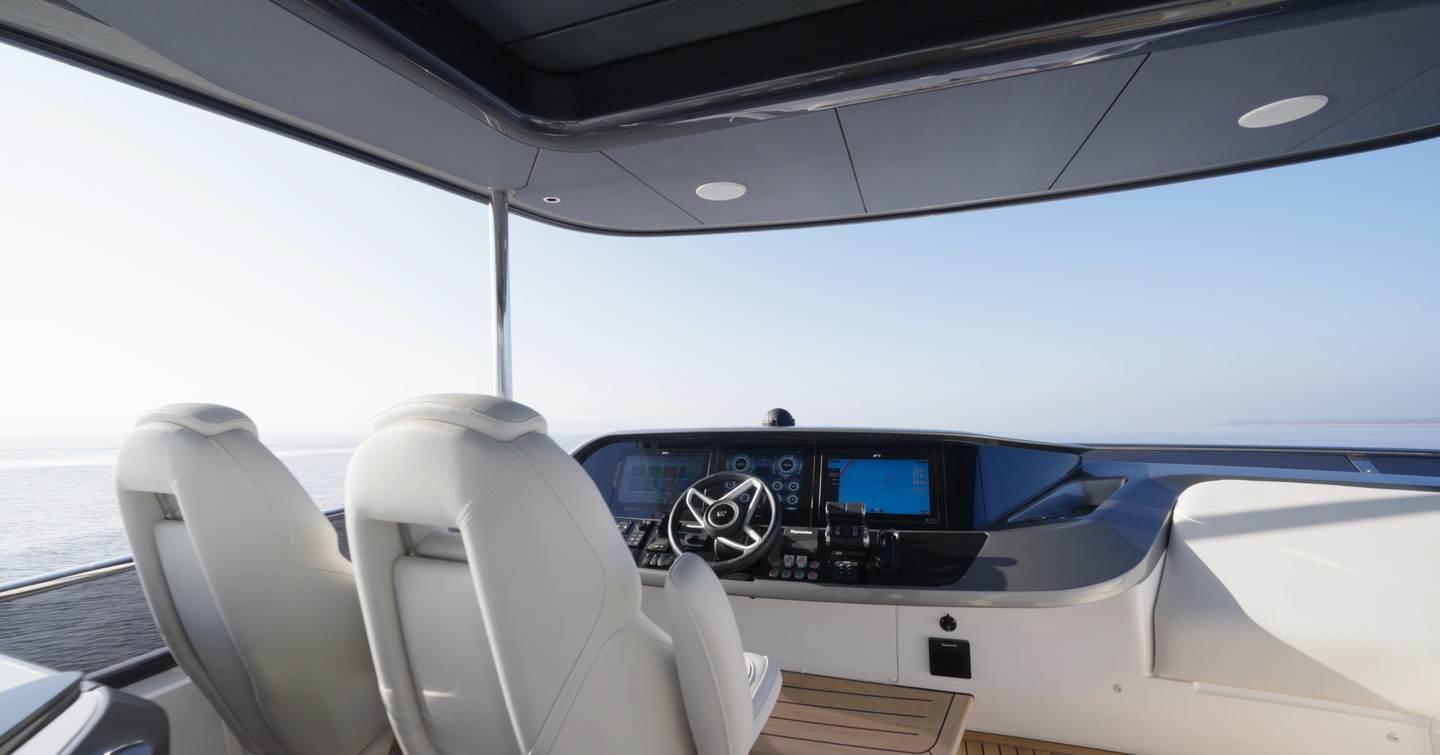
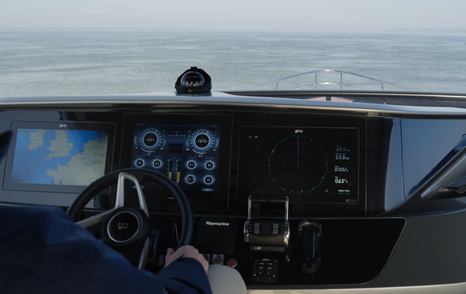
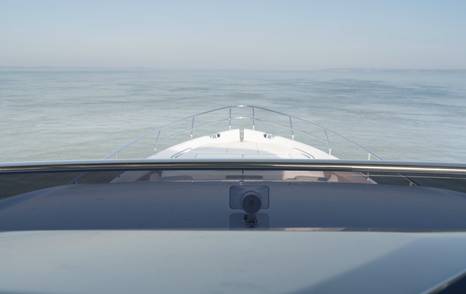
Lower Helm
The first thing that stands out is how quiet it is at the lower helm. Cruising at around 22-23 knots, the sound readings come in at 70dB, which is about the same as driving a car on the motorway. Considering 24 cylinders are working away and the amount of power on tap, that’s very impressive.
What this means in practice is that if you're down here covering ground, rather than lounging on the flybridge, it’s a lot less tiring. Constant engine noise can wear you down over a long passage. The other side of that, of course, is that if anything was squeaking, creaking, or banging, it would stand out a mile. But even though it was calm on test, there’s none of that noise - it’s fine, even cruising at faster speeds.
The dash layout mirrors the upper helm fairly closely. There’s a Böning screen, twin MFDs come as standard at the lower helm, and the setup feels familiar. Everything’s a little bit further away - you end up slightly perched on the edge of the seat - but once it’s all set, the overall view is excellent. The seating is similar to upstairs, too. Sit back, and you get a clear view of the bow, the screens, and most of the surroundings.
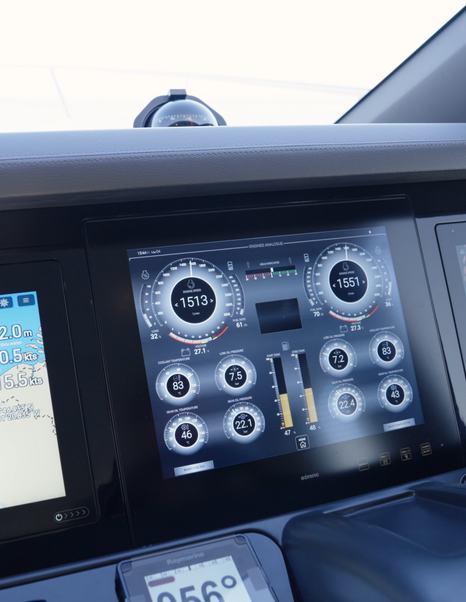
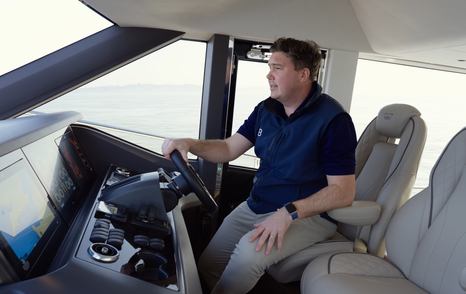
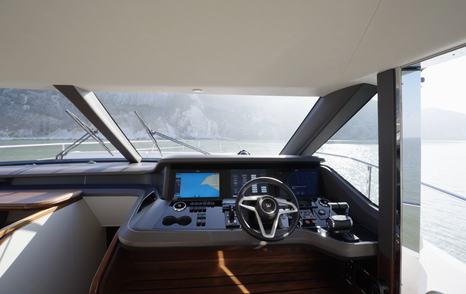
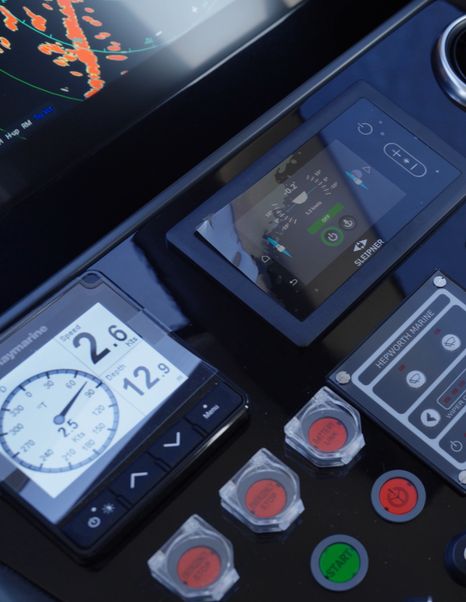
Visibility is generally good, but the thicker window frames do create a few blind spots - particularly if something’s approaching from the starboard bow. The thin mullion in the centre of the windscreen is fine, but the galley and fridge block some of the port quarter view. A bit of teamwork will be needed if you’re making a hard turn to port - someone might need to stick their head out of the window to double-check.
The dash itself feels a little bit piecemeal. Different systems use different screens - a screen for the windscreen wipers, another for the stabilisers, and a couple of smaller Raymarine displays. It’s not as clean or uniform as the fully integrated glass bridges you find elsewhere these days. Plus, they’ve used the same shiny surface as upstairs, which looks smart when new but is prone to scratches. A more matte finish would work better.
Still, there’s a co-pilot seat and more seating close by, so four people can comfortably sit up here and enjoy the ride. And the real takeaway from this part of the boat is the feeling of fast, comfortable, quiet cruising. Calm conditions help, but even so, it’s seriously impressive how quietly and easily this yacht covers ground at these speeds.
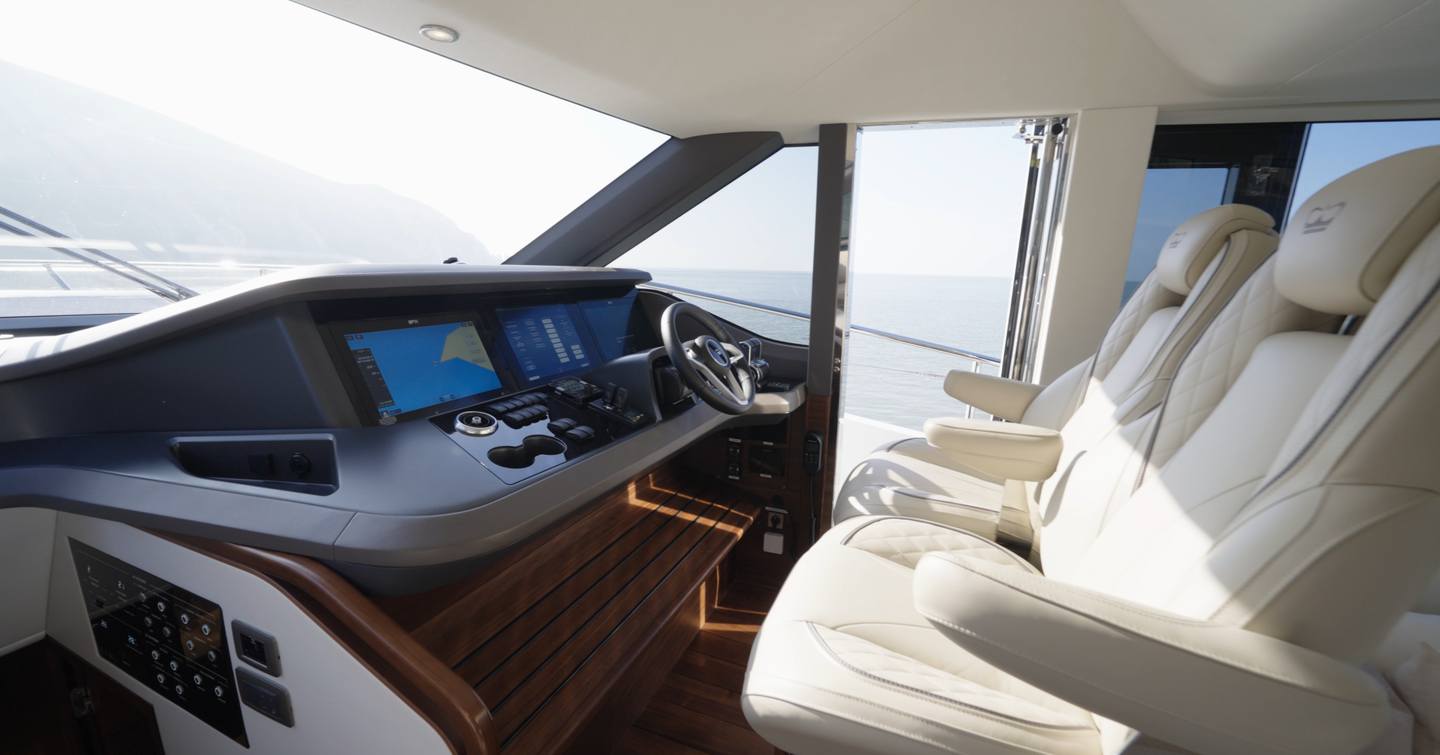
This boat doesn’t have a tender garage - and it’s not an option either - but there is a hydraulic bathing platform with a weight capacity of 550kg, enough to handle a 4m (13.1ft) tender comfortably. Nice detail too - the Princess logo is etched into the teak, and the grates on either side allow water to flow cleanly through when the platform is lowered.
It’s not a beach club setup - not what they’ve gone for with the Y72 - but the little perch at the back makes a lovely spot to sit and soak up the sun. Above the platform is a storage space set up for cleaning gear or Seabobs with a charger installed inside.
Our Y72 test boat came very heavily specified - basically a full Mediterranean spec - including a cassette passerelle. That pops out and connects to the quayside when you’re moored stern-to, like you would be in the Med, making it simple to get on and off.
Now, the S72, which shares the same platform as this yacht, is the sportier S Class version and does have a tender garage alongside the crew space. So if a tender garage is high on your list and you still want a Princess of this size, the S72 is the one to go for. Otherwise, the Y72 covers a different set of priorities.
Last thing at the transom - there are a couple of shower options. That socket is for a plug-in deck shower, plus there’s an overhead shower and the usual pull-out shower for a quick rinse after a swim.
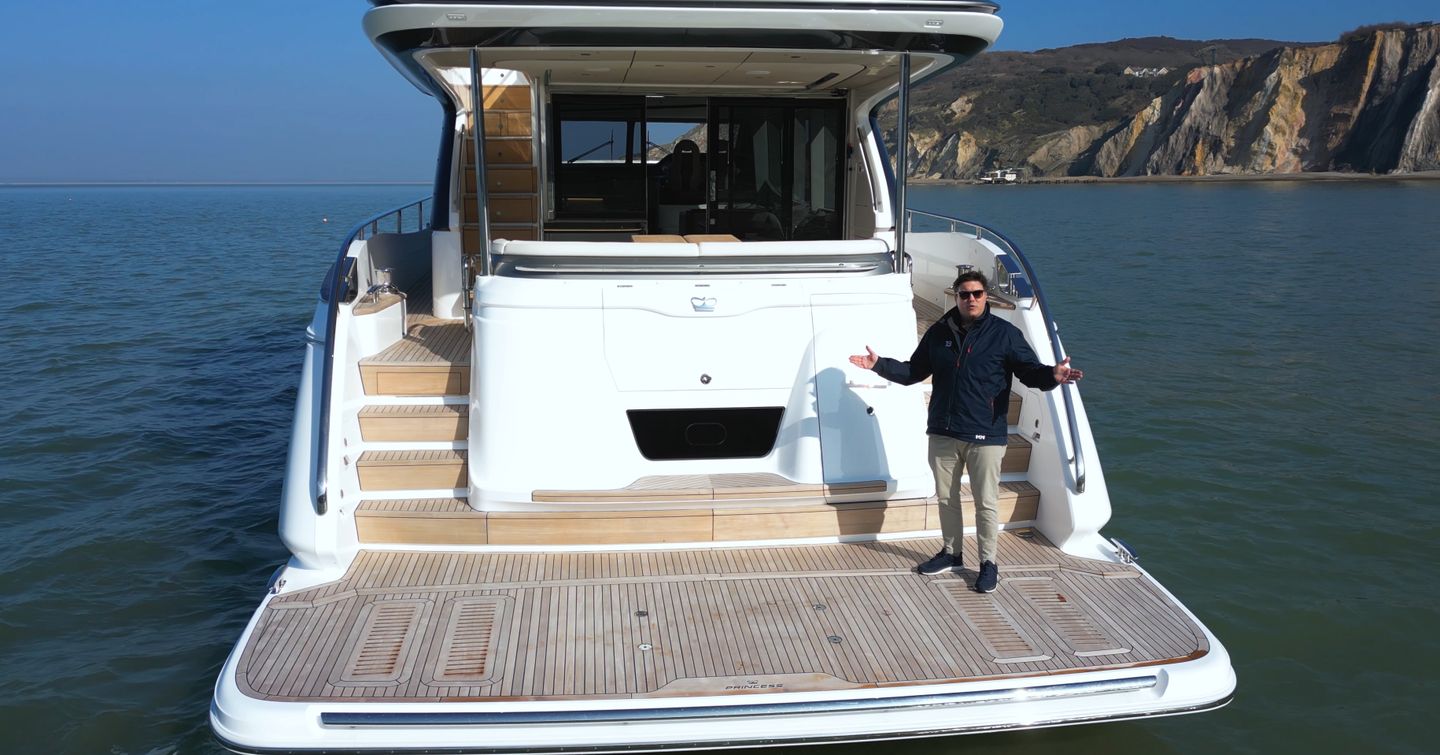

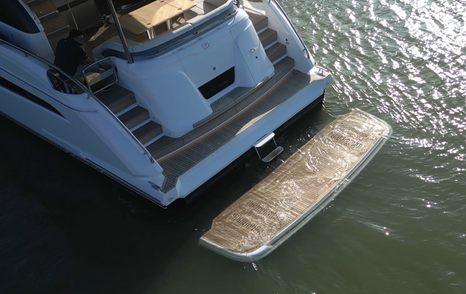
Cockpit
The cockpit is exactly what you would expect. There’s a decent seating area with a table that folds out to double its size when needed for dining. The backrests run all the way around too, which is a nice touch - even if you’re sitting on one of the end seats, you still get a bit of support to lean back and relax properly. There’s space along one side for a couple of director’s chairs as well if you want to add extra seating.
That said, it doesn't offer as many features as the likes of the Pearl 72 or Galeon's 700, so if you're looking for more functionality, there are better options on the market.
It is practical too. Big lockers sit under each end bench - good-sized ones, easily large enough for a life raft, though here they’re being used for lines, life jackets, and the usual gear. Everything stows neatly, and it’s easy to get at when you need it. The mooring gear looks the part - a lovely, big, chunky cleat with a fairlead built neatly into the bulwark. It would have been nice to see a rope bin in this area, like you get on a Ferretti, where you can put the ends of the lines away instead of leaving them lying around - but that's a small point.
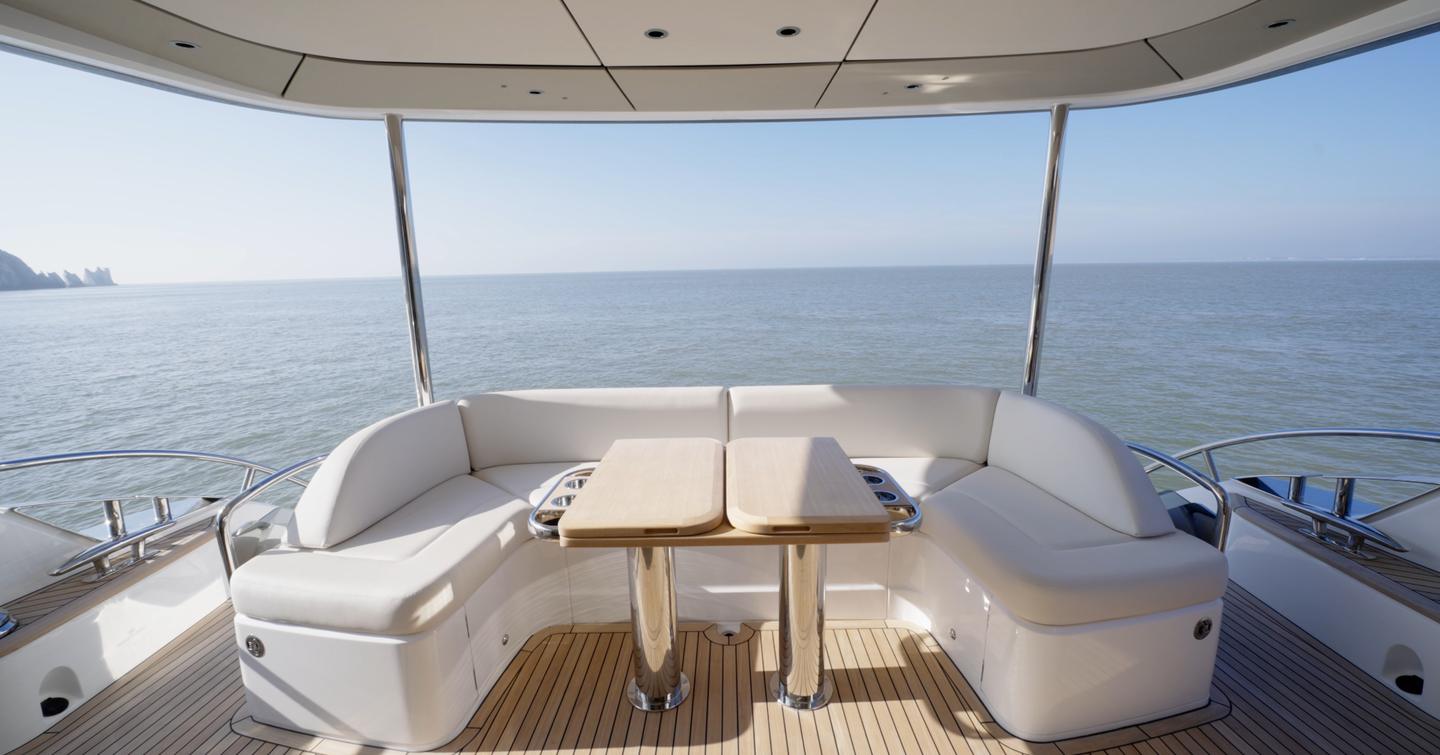
There isn’t a bar in this cockpit, but that’s no real issue with the aft galley layout. A hatch pops open to connect directly to the galley. Steps up to the flybridge are also in this area, and there are plenty of practical touches - the boat hook is mounted just above, ready to grab in a hurry, and down below, there’s quick access to the fuel shut-off, manual bilge pump, and fire suppression system. All the important safety gear is right where you want it.
Finally, there’s the option of a third docking station at the back. It’s a cost option but a useful one, especially for stern-to mooring.
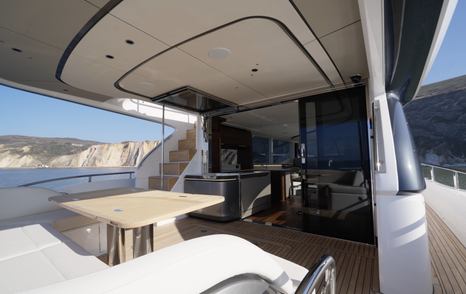
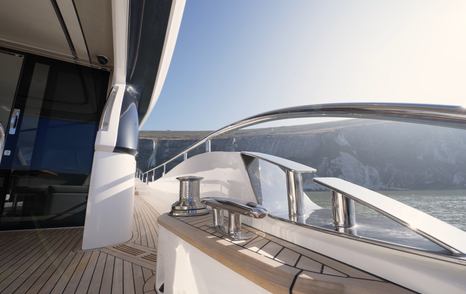
Side Decks & Foredeck
It’s a big boat, but it should be a relatively easy one to crew. Moving around the decks feels safe and secure. The rails come up nice and high with thick gauge guardrails above, and it feels solid underhand, as it should.
A few steps forward bring you to the side door into the helm. There are a couple of flies in the ointment, though, such as no boarding gates on deck. So if you’re side-to a high quayside, you can’t just step off - you’ll always have to go down to the bathing platform.
Otherwise, the practical setup here is spot on. The storage is excellent - huge lockers on both sides, and they are linked across the boat. There’s room for a good stack of fairly large fenders, stowed without eating into the anchor locker space.
The forward living area can be covered with a canopy if needed - not something you would bother with on an 8-degree day like this. It is not a dining space, judging by the size of the table, but it is a brilliant place to perch, even when the boat is trickling along at displacement speed. The seating is flexible too - the usual pop-up backrests are there facing outboard, but there are also pop-up sections facing inward, so you can create benches facing into the boat on both sides if you want to.
The walkway is flat as well - no annoying step to catch your foot as you head right forward to the bow. Up here, there are the cleats, the anchor windlass, and the fairleads built in as they should be. The anchor lockers are split - one side is a shallow, lined locker with a drain and windlass control, and the other is the chain locker.
There is no dedicated place to tie off fender lines in the chain locker, which is a bit of a miss, but the fender storage elsewhere is so good that it just about gets away with it. Still, it would be nice to have somewhere to tie things off properly, especially given how deep that locker is.
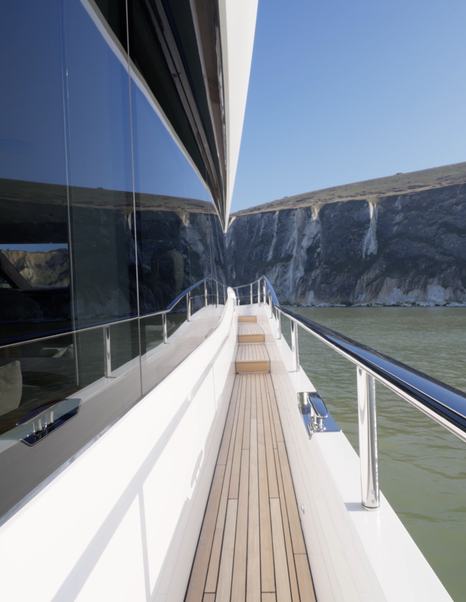
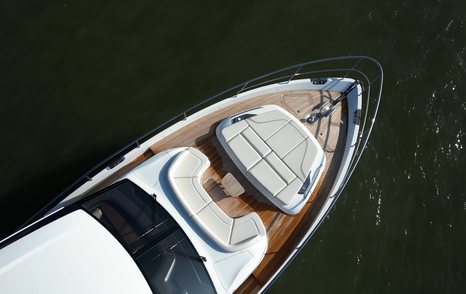
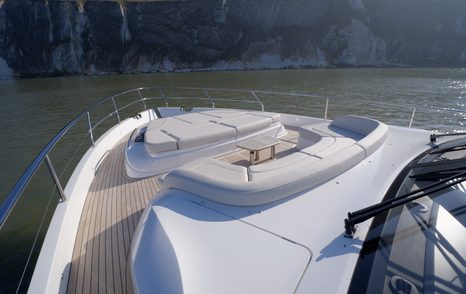
Flybridge
There’s an option to keep the tender up here, though it’s hard to see why you would - it works well launched from the hydraulic platform. Personally, it makes far more sense to keep these lovely big sunpads instead. As an extra, you can also fit a sunshade that pops out to give a bit of cover in this area.
Moving amidships, the bar and dining space take centre stage. The table here is slightly different from the one downstairs - no opening leaves this time. You can fully remove the central section, which is a clever bit of design. It gives flexibility - if you’re hosting a big dinner party, keep it in place, but if you’re just having drinks, you can split the tables for easier movement in and out of the seating.
The return layout of the bar gives it more presence - it's not just a wet bar shoved in a corner. There's a Kenyon grill under the hatch, a decent-sized fridge beneath that, and a Vitrifrigo top-loading drawer fridge, an ice maker, and storage with a bin underneath.

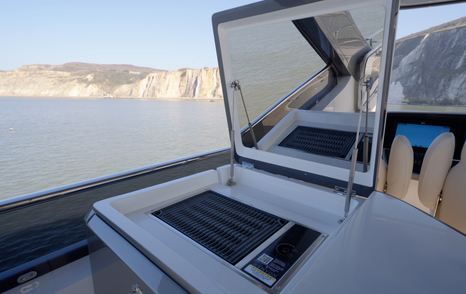
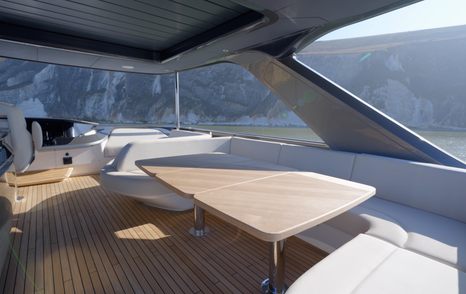
Forward of that is the hard top. It’s a cost option - and not a cheap one - but likely to be popular just because of how much flexibility it adds. Wrestling with a bimini on a boat this size isn’t ideal, and here, the system is simple - a series of tilting vanes that open and close. This boat has the tilt-only version rather than the full sliding one, but it still offers a good amount of shade. Personally, a canvas roof feels more open when it’s pulled right back, but this setup should be a lot quieter when the boat’s moving along.
Right forward, the adjacent area is another clever piece of design. It works for all sorts of reasons - you can sit back and chat with people around the bar or stretch out facing forward when underway. The seats are properly laid out - one on either side - and you can even see the screens and stay involved with what’s happening at the helm. It’s a good setup. Overall, it’s a well-designed, well-thought-out flybridge.
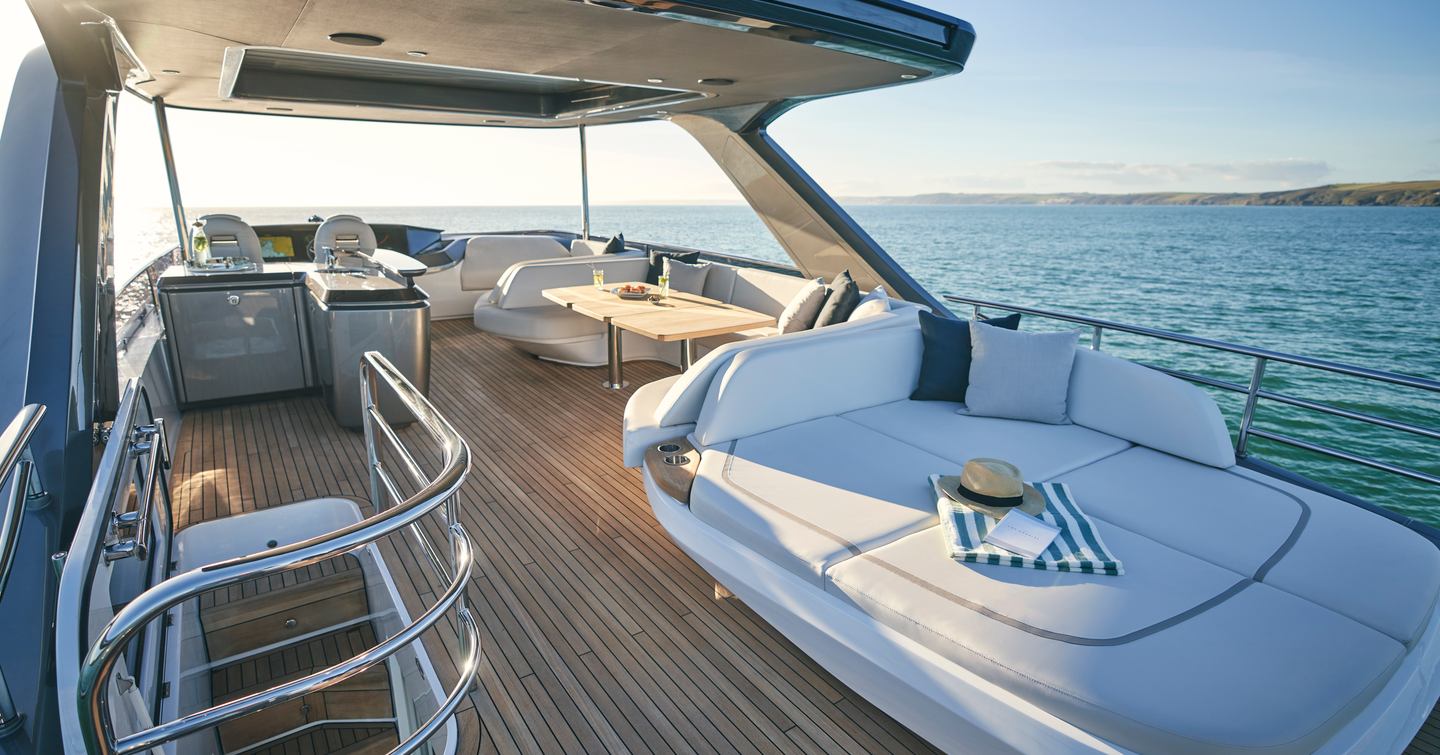
We were unable to obtain up-to-date pricing for the Y72, but you'll see in the listings section below that the actual boat we tested is for sale, and you can contact the broker directly for more information.
In terms of value, the Princess is a high-quality, British-built product, and there is a premium to pay for that, as there is for its rivals from Italy, such as the Azimut 72 and Ferretti 720. The Pearl 72 and Galeon 700 Fly are both cheaper to buy, but neither finished with quite the same level of finesse as the Y72.
Our Options & Pick
We'd certainly opt for the larger engines, both for the performance they provide and with resale value in mind. Likewise, most buyers are going to want to see boxes ticked for the hard top, fin stabilisers, air conditioning, and the upgraded navigation package with the extra 16in Raymarine MFD at the upper helm.
Some other, more personal extras to consider would be the walnut satin interior wood, bar stools in the saloon, sliding twin cabin berths, 4.1m hydraulic passerelle, teak decks, laundry equipment, and the primary (27kw) generator upgrade.
Our Verdict
The reason the Y72 has been so popular is fairly simple - it’s very good at a lot of things. The exterior spaces are well judged, the interior is spacious and elegant, and while it’s a big boat, it still feels easy enough to handle. Out on the water, it performs better than most in its sector.
If you're after a tender garage, or a galley set further from the cockpit, or maybe something with a bit more visual drama inside, other boats might suit better. But as an all-round package, the Y72 has it. Confident, capable, and easy to live with - it's a triumph in the 70-foot flybridge bracket.
Reasons to Buy
- Timeless styling
- Flexible performance
- Private owner's cabin access
- Well proportioned deck spaces
- Great fit and finish
Things to Consider
- Crew cabin isn't huge
- Interior is a little plain
Looking to own a Princess Y72? Use YachtBuyer’s Market Watch to compare all new and used Princess Y72 Yachts for sale worldwide. You can also order a new Princess Y72, customized to your exact specifications, with options for engine choice and layout configuration. Alternatively, explore our global listings of new and used yachts for sale and find your perfect yacht today!
Rivals to Consider
Compared to the Princess S72, the Y72 leans more toward comfort and cruising ease. The S72 is the quicker boat, cruising at 34 knots and offering an extra cabin to sleep up to ten guests. It suits owners who want a faster, more dynamic yacht. The Y72, with its four cabins and full-beam master, is better suited to relaxed, long-distance cruising where refinement matters more than outright speed.
The Azimut Fly 68 takes a different approach inside, with a more playful, design-led interior. Where the Y72 feels clean, modern, and familiar, the Azimut uses curves, bold colours, and textures to create a dreamlike feel. The Azimut has the flair, but the Y72 brings a more open, airy atmosphere and a calmer overall layout.
The Sunseeker Manhattan 68 is a close match on space and layout, offering a private-access owner’s cabin, three guest cabins, and a galley-aft main deck. It’s slightly smaller overall but well packaged. The Y72 has the edge in finish quality and interior flow, especially with its true single-level main deck.
The Absolute 72 Fly moves things up a step in size, with a larger owner’s cabin, a more expansive dining area, and a little more big-yacht feel overall. It matches the Y72 for guest accommodation, but the Absolute feels heavier and more substantial, while the Y72 stays sharper on the water and easier to handle.
The Ferretti 720 offers a very similar layout to the Y72, with a full-beam owner’s cabin and three guest cabins. It shares much of the Absolute’s character too, but needs a small step up in the saloon to clear the cabin below. It shows how well Princess has handled the Y72’s single-level layout without compromise.
The Fairline Squadron 68 stands out for its long range - 1,584 nautical miles - making it a strong choice for longer cruising legs. The Y72 feels the more contemporary and agile yacht, but the Fairline has the legs for serious passage making.
The Gulf Craft Majesty 72 offers a much shallower draft than the Y72, opening up more cruising grounds in shallow waters. It suits owners who want to island-hop without worrying about depth, though the Y72 feels the more refined and capable boat overall.
Considering a new yacht? Explore Princess' entire current range to find the model that best suits your needs, and compare it with alternatives from competitors to ensure you make the perfect choice.
Specifications & Performance
- Builder Princess
- Range Y Class
- Model Y72
- Length Overall 21.77m
- Beam 5.52m
- Draft 1.72m
- Hull GRP
- Cabins 4
- Berths 8
- Crew 2
- Max Speed 34 knots
- Fuel Capacity 4,500 Litres
- Fresh Water Capacity 836 Litres
- Engine Model 2x MAN V12-1650
- Engine economic speed 9 knots
- Engine max range (speed type) 580 (nm)
Performance Data
Princess Y72 version 2021. *Data collected by Yacht Buyer during testing.
Test Engines Twin MAN V12-1650
- RPM
- Knots
- Liters Per Hour
- Liters Per Mile
- Range (nm)
- Decibels
-
- ECO
- 1,000
- 9.0
- 70
- 8
- 579
- 55
-
- 1,200
- 11.0
- 120
- 11
- 413
- 66
-
- 1,400
- 13.0
- 180
- 14
- 325
- 64
-
- 1,600
- 17.0
- 250
- 15
- 306
- 64
-
- CRUISE
- 1,800
- 22.0
- 340
- 16
- 291
- 67
-
- 2,000
- 26.0
- 420
- 16
- 279
- 70
-
- 2,200
- 30.0
- 540
- 18
- 250
- 70
-
- MAX
- 2,400
- 344
- 640
- 19
- 240
- 72
Yacht Load: 25 Litres of water 75 Litres of fuel 5 members of crew air temperature of 8 °C
Available Stock
Interested in a Y72?
NEW Build
Find your local dealer for a personalised, no-cost consultation
or just request
Brochures & Pricing
Used & In Stock
Looking for a ready-to-go Y72 or pre-owned options? Explore all inventory of the Y72 available worldwide

